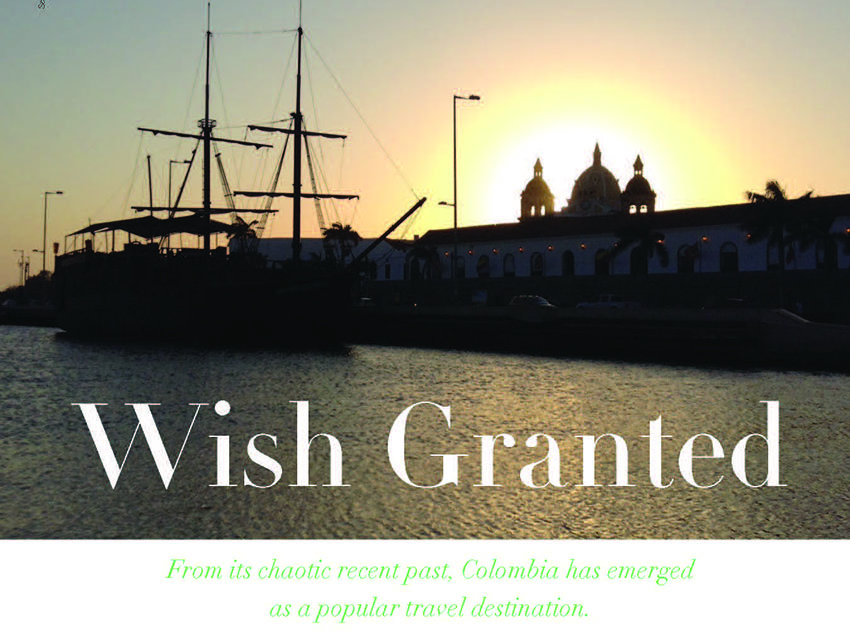Desperately Seeking Solitude
“I love tranquil solitude…” Shelley, the ill-starred poet, he of the golden pen, knew the true value of solitude. And so do we. All around, we see the vaunted worth of the priceless melt away. The most highly prized dwindles, fades into the commonplace. But solitude eludes the calipers of ordinary measure. Not easily found today. How much more difficult tomorrow? Solitude. Such a luxury. No, the new luxury. It’s the exclusive reserve of the wealthy…or the ingenious. Presented in these pages, still spared the encroachment of progress, crowds and all manner of acclaim, is a choice selection of refuges where Solitude is valued above all else.
Musha Cay
David Copperfield, who just happens to be the owner of Musha Cay in the Bahamas, modestly calls his island, “the most beautiful place on the globe.” Not for anyone who wants to rough it. Rather a refuge for anyone who unashamedly wants to be spoiled. The island is staffed by gentle folk whose pleasure it is to see that you are content, content, content…morning to night. To be left in peace. Swim in the free-form beach-side pool or fl oat the day away in the calm of the Caribbean. Take a turn at wind-surfing, a spell of snorkeling, tennis on a flood-lit court. Picnic on a different beach every day. While you’re in residence, you’re the supreme command. You can rule your kingdom in solitary splendor or share it with up to a dozen forever-grateful friends. Your modest housing is Highview, a manor house of 10,000 square feet, rimmed by mahogany decks with views of the far rim of the world. Travel to and from Musha Cay is via the island’s Twin Otter aircraft, transport deemed more than satisfactory by the likes of Robin Williams, Oprah Winfrey, Tim McGraw and….oh why go on and on. Isn’t it enough to promise that on Musha Cay you will be….well, let’s just say: Content.

Photo by Erico Hiller
Lamu
One of seven islands lying just off the east African coast. Today its political allegiance is to Kenya. Its cultural allegiance, however, is to the 15th century, when Arab traders sailed the seas unmolested and wealthy beyond all imagining. Their ways are here preserved. Revered. Life in these narrow, crooked streets moves no faster than a donkey’s pace…the same donkeys that still carry water jugs from well to dwelling. The beaches, called shela, are broad. White. Empty. The sea is limpid. Stay in a guest house, reserved for you alone. Barefoot girls, veiled in white linen, place baskets of mango and papaya on the doorstep at dawn. Feast by moonlight on the catch brought fresh from the sea by fishermen sailing the dhows built by their fathers and grandfathers. Each day is chanted into wakefulness by the imam high atop the ancient mosque. Here Swahili is the spoken word. Karibu. Welcome…welcome to Lamu.
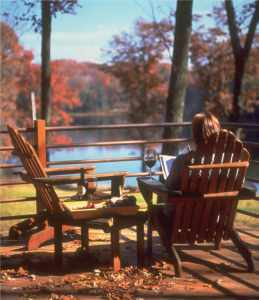
Photo courtesy of Canoe Bay
Canoe Bay
Solitude, serenity, sylvan quiet. Enshrined deep in the Wisconsin woodlands, Canoe Bay is situated on the edge of deep, glacier-formed Lake Wahdoon. Nature provides the setting. Frank Lloyd Wright provided the inspiration by which this one-of-a-kind resort takes architectural shape. Rattenbury Cottage is hidden away on a 280-acre property. Designed by one of Wright’s most astute devotees, it features the open-air layout that characterizes so much of the Great Master’s creations. A large living room with soaring ceilings, polished wood paneling and massive stone fi replace…king-bedded sleeping space, huge bathroom with two-person whirlpool spa, gleaming white oak floors, broad cantilevered deck with unimpeded lake vista…it all adds up to privacy, promised and delivered. No motor boats or jet skis disturb the lake’s tranquility. The fully equipped boathouse is at your disposal complete with kayak, canoe, paddles. The gourmet picnic basket is only a phone call away. Dine in the cottage, on its deck, or if you prefer, in Canoe Bay’s glass-enclosed lakeside dining room. Under the star-studded night skies, the call of the loons is unchanged since primeval times.
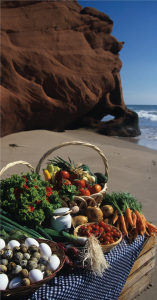
Photo courtesy of Iles de la Madeleine
Iles de la Madeleine
Adrift in Quebec’s Gulf of St. Lawrence, the Iles de la Madeleine (aka Magdalen Islands) form an archipelago some 65 miles long, bent like a fishhook…a dozen islands, home to the Acadians. Longfellow immortalized the Acadians with his well-beloved poem, “Evangeline.” But Longfellow’s Acadians fled the tyranny of Britain to settle in Louisiana. He said not a word about those who eschewed Louisiana in favor of staying in what Canadians affectionately term “the Maggies.” Theirs is a unique community….sea-faring, song-loving, proud of their heritage. Hospitable to visitors, perhaps because so few fi nd their way to these charming wave-washed specks of land. Red cliffs, green hills and golden beaches. A meterological quirk assures mild winters, warm autumns, gentle summers. The people have lovingly preserved the French of yesteryear…musical in its cadences, well suited to a pace of life unmatched in the world beyond the horizon. Here life is governed by tide and wind, by surf and wave. Once a true convent, today the Domaine du Vieux Couvent receives no more than a handful of visitors at a time. Each is settled into comfortable suites, tucked between a lighthouse and a working fishing pier. Walk the beaches in peace. Consort with seals and dolphins. Ship out to sea for the day with a pecheur who will gladly take you aboard. Feast by candlelight on freshly hauled lobster and crab…on greens grown right here in island gardens. A glass of vin ordinaire in the local café. A lesson in surf casting taught by the great-great grandson of an islander who cast into these very waters a century and a half ago. Pack a sweater, sunglasses, bathing suit. Leave behind your watch and calendar, your laptop, your cell phone. Time in the Maggies is unrelated to the time you leave behind at home.
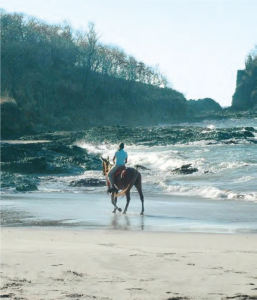
Photo courtesy of Cabo Velas
Cabo Velas
On the dry breezy coast of the Guanacaste region of Costa Rica, just north of the town of Tamarindo, that’s where you’ll find Cabo Velas. A traditional working ranch, complete with livestock and tropical orchards sprawled over 1700 acres on a secluded seaside peninsula. Yours and only yours. A week? A month? Whatever. No other guest sets foot on those 1700 acres while you’re in residence. Your life unwinds in a thatched rancho. Your large bedroom and separate dressing room open onto a beachfront verandah. Shower indoors or out. Upstairs…a second slightly smaller suite. A guest or guests? It’s your say. Swim on any of five…yes, five…beaches, each secluded by seagrape, hibiscus and palms. Snorkeling, diving, kayaking? Of course. Or perhaps a ride before breakfast along a Pacific beachfront. Dine in the Rancho Principal, a screen-surrounded dining room, edged by a two-level terrace and beyond….the salty deep. White water rafting, golf, tennis, cycling…only 30 minutes away. But really, just staying put at Cabo Velas in the heartland of Costa Rica will doubtless suit you very, very well. Cabo Velas. Olé!
Editor’s Note: For more information on these properties, log onto the following web sites: MUSHA CAY (mushacay.com); CANOE BAY (canoebay.com); DOMAINE DU VIEUX COUVENT (domaineduvieuxcouvent.com); LAMU (magicalkenya.com).
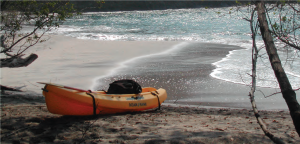
Photos courtesy of Cabo Velas

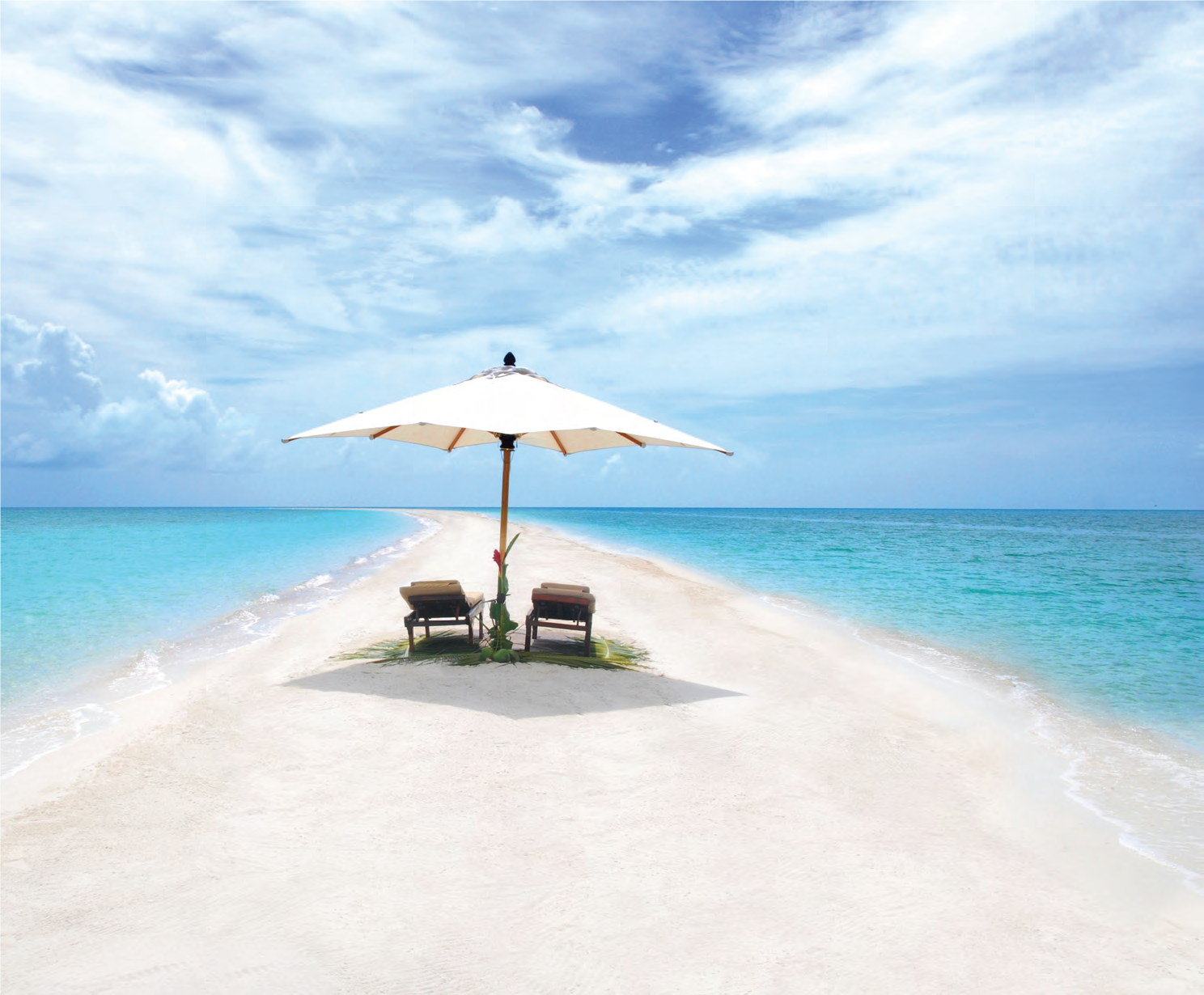

 ackpot is waiting at one of AC’s world-class spas, where skincare regimens play a major role in relieving the outward signs of stress—and the hotels leave little to chance. “We’re the newest spa in Atlantic City,” says Jane Mackie of the Chelsea Hotel’s Sea Spa. “The décor is retro—close to nature. There’s an opportunity to do natural and healthy treatments here.”
ackpot is waiting at one of AC’s world-class spas, where skincare regimens play a major role in relieving the outward signs of stress—and the hotels leave little to chance. “We’re the newest spa in Atlantic City,” says Jane Mackie of the Chelsea Hotel’s Sea Spa. “The décor is retro—close to nature. There’s an opportunity to do natural and healthy treatments here.” ray Organic Treatments, including the Body Renewal & Detoxification Therapy, Organic Firming Massage, and Organic Facial, utilize key ingredients in sea salts and seaweed, which rank among the purest form of therapeutic organic substances. Seibel also shares with clients his concerns regarding certain skincare products. “Many facial products may smell nice, but many people, whether they know it or not, may be allergic to them.” He recommends the Spa’s Organic Facial, noting that it works for those with sensitive skin and folks wanting “something different.” Every day you leave the house, you’re rolling the dice when it comes to the health of your skin. So how ironic is it that the one place you can’t lose is the gambling capital of the East? Just another reason to adore New Jersey.
ray Organic Treatments, including the Body Renewal & Detoxification Therapy, Organic Firming Massage, and Organic Facial, utilize key ingredients in sea salts and seaweed, which rank among the purest form of therapeutic organic substances. Seibel also shares with clients his concerns regarding certain skincare products. “Many facial products may smell nice, but many people, whether they know it or not, may be allergic to them.” He recommends the Spa’s Organic Facial, noting that it works for those with sensitive skin and folks wanting “something different.” Every day you leave the house, you’re rolling the dice when it comes to the health of your skin. So how ironic is it that the one place you can’t lose is the gambling capital of the East? Just another reason to adore New Jersey.
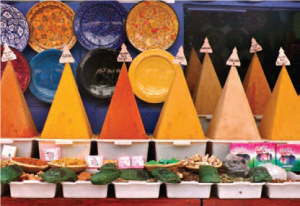 Here come the choppers. Swirling into Mogadishu. Smoke, dust and sand fill the screen. Swarms of half-naked kids race past adobe buildings that explode into flames and deadly debris. Somalia never looked more hellish. The American Rangers never looked more battle-ready. It’s Blackhawk Down—based, of course, on actual events and directed by Ridley Scott, who is mighty pleased with his blockbuster film. Dramatically a winner, financially a dreamboat that, reportedly, earned its investors “ten bucks on the dime.” And filmed On Location. Switch to Lebanon’s land-mined desert. Leonardo DiCaprio, hands aloft in surrender, must outfox both the ill-advised CIA as well as the local terrorists.
Here come the choppers. Swirling into Mogadishu. Smoke, dust and sand fill the screen. Swarms of half-naked kids race past adobe buildings that explode into flames and deadly debris. Somalia never looked more hellish. The American Rangers never looked more battle-ready. It’s Blackhawk Down—based, of course, on actual events and directed by Ridley Scott, who is mighty pleased with his blockbuster film. Dramatically a winner, financially a dreamboat that, reportedly, earned its investors “ten bucks on the dime.” And filmed On Location. Switch to Lebanon’s land-mined desert. Leonardo DiCaprio, hands aloft in surrender, must outfox both the ill-advised CIA as well as the local terrorists.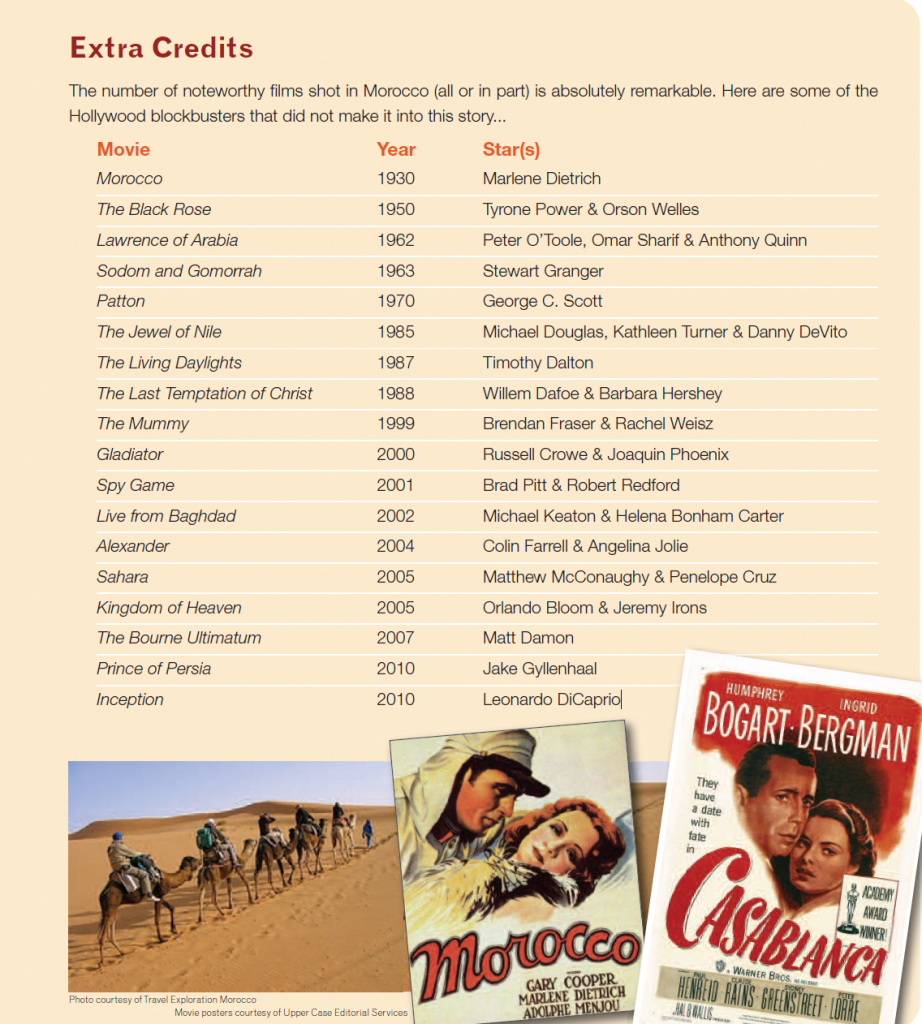
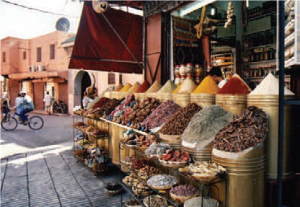



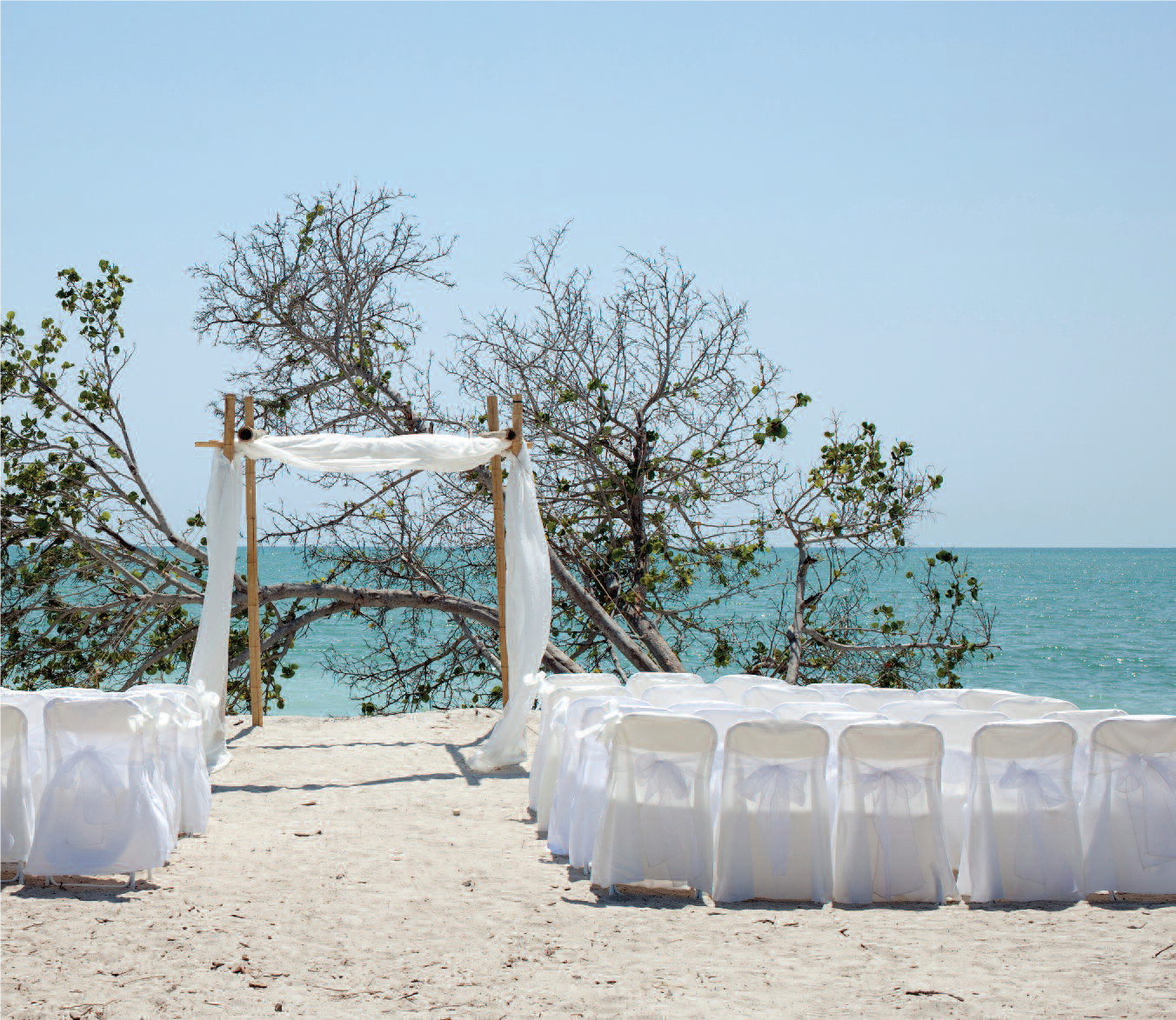
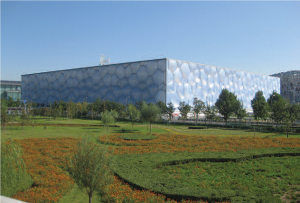

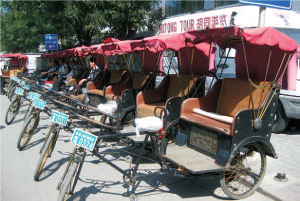 eijing’s restaurant scene is cosmopolitan. Indeed, when I asked my second-day guide, Clark Du, where I could sample a “typical” Beijing meal, he shrugged. He and his friends typically ate Italian or Japanese. I had good luck food-wise on my return to Beijing. In the spirit of full disclosure, I should mention that I stayed at the new Ritz-Carlton in the Financial District. The room was clean and sleekly comfortable and the food was very good. However, Chinese food still can range from good to bad to ugly. That being said, each meal—from the budget Jya-jiang noodles in a Hutong restaurant, to the steaming bamboo baskets of pork and crab dumplings in a fluorescent-lit shopping mall, to the bean curd and seafood served in a former Imperial garden by waitresses in Manchu robes—has its rewards. You do need to be choosy when dining out, as some aspects of Chinese food—and restaurant hygiene—are not for the meek. As a rule, I suggest staying away from spare parts.
eijing’s restaurant scene is cosmopolitan. Indeed, when I asked my second-day guide, Clark Du, where I could sample a “typical” Beijing meal, he shrugged. He and his friends typically ate Italian or Japanese. I had good luck food-wise on my return to Beijing. In the spirit of full disclosure, I should mention that I stayed at the new Ritz-Carlton in the Financial District. The room was clean and sleekly comfortable and the food was very good. However, Chinese food still can range from good to bad to ugly. That being said, each meal—from the budget Jya-jiang noodles in a Hutong restaurant, to the steaming bamboo baskets of pork and crab dumplings in a fluorescent-lit shopping mall, to the bean curd and seafood served in a former Imperial garden by waitresses in Manchu robes—has its rewards. You do need to be choosy when dining out, as some aspects of Chinese food—and restaurant hygiene—are not for the meek. As a rule, I suggest staying away from spare parts.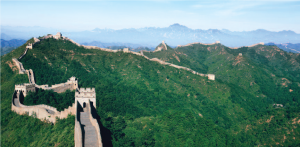 ere was hoopla about a funny story on Chinese food, sanitation and hygiene written by David Sedaris. To be sure, the non-hotel toilets can be daunting and require strong glutes and thighs. Use your imagination. Also, it’s a smart idea to carry you own tissue in case there’s a run on toilet paper. On the bright side, I think that, thanks to the Olympics, the Chinese have cleaned up their act with respect to uncovered hacking, phlegm-spitting and allowing babies to defecate in the streets. At least I didn’t notice it this trip. To many the hygiene is a deal-stopper, but to me, I say Vive la Difference. It’s all part of the great adventure that is China.
ere was hoopla about a funny story on Chinese food, sanitation and hygiene written by David Sedaris. To be sure, the non-hotel toilets can be daunting and require strong glutes and thighs. Use your imagination. Also, it’s a smart idea to carry you own tissue in case there’s a run on toilet paper. On the bright side, I think that, thanks to the Olympics, the Chinese have cleaned up their act with respect to uncovered hacking, phlegm-spitting and allowing babies to defecate in the streets. At least I didn’t notice it this trip. To many the hygiene is a deal-stopper, but to me, I say Vive la Difference. It’s all part of the great adventure that is China.
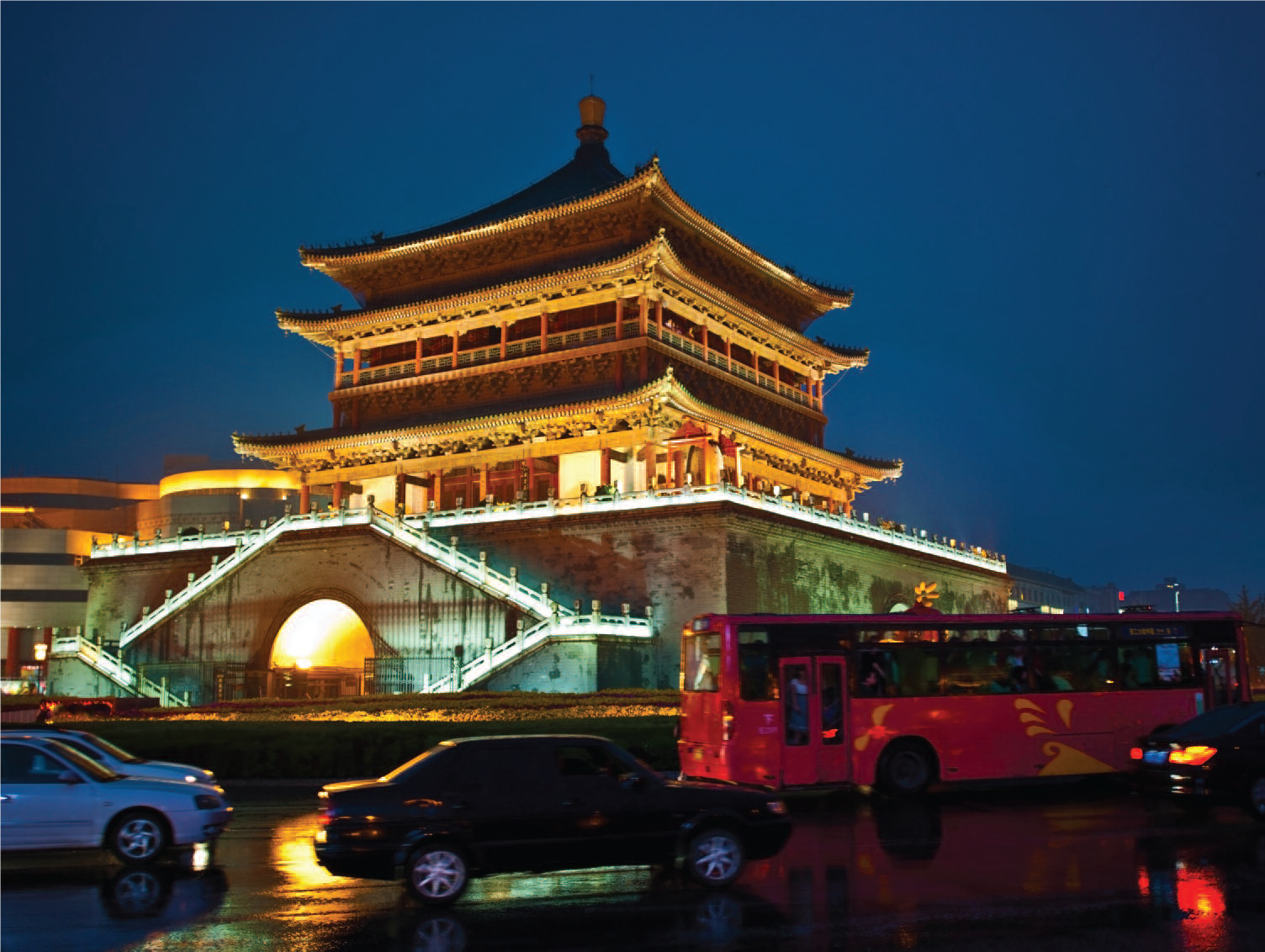
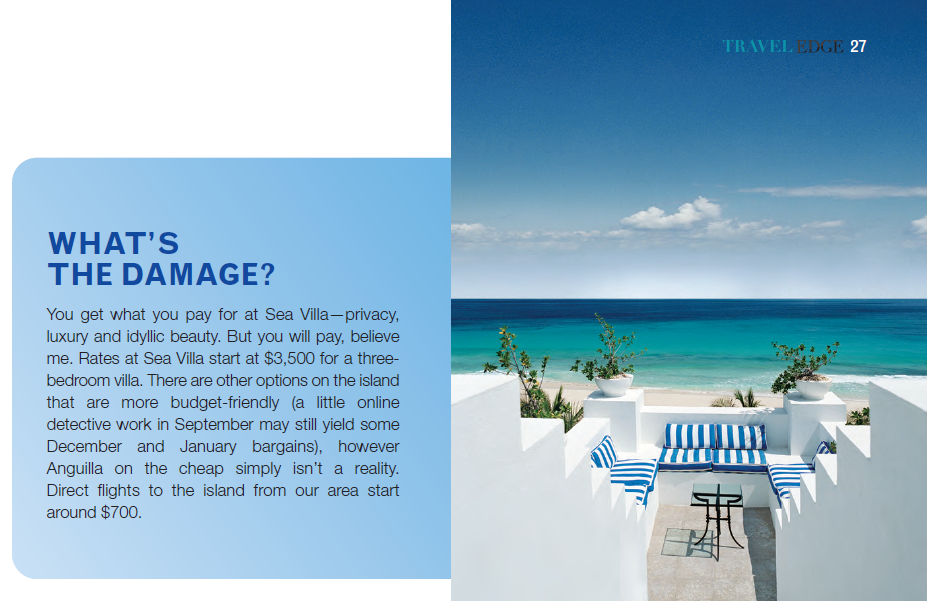 Furthermore, we’re all looking forward to a present free Christmas. You heard me. No Christmas presents! For the second year in a row, we are happily swapping center-city shopping—with its canned Christmas carols, its street corner ding-a-ling Santas, its life-threatening escalators and all those green/red/green-again traffic lights (and still we don’t budge)— for a tropical sunrise by our utterly beautiful pool. Or perhaps a pre-breakfast snorkeling expedition to watch the lobster lolling in the deep just off our private beach. Our 20-year-old pre-law genius puts it this way: “Dad definitely does not need another Hermes necktie, Mom does not need another silk scarf and no one in this house needs another cashmere anything.” Miss 18 and Worldly Wise says, “Christmas on a beach and under a palm tree? Heaven!” Last and anything but least, our 16-year-old Wimbledon hopeful says Christmas afternoon men’s doubles tennis is, like, “Crazy.” How my family came to opt out of that most traditional of American holidays
Furthermore, we’re all looking forward to a present free Christmas. You heard me. No Christmas presents! For the second year in a row, we are happily swapping center-city shopping—with its canned Christmas carols, its street corner ding-a-ling Santas, its life-threatening escalators and all those green/red/green-again traffic lights (and still we don’t budge)— for a tropical sunrise by our utterly beautiful pool. Or perhaps a pre-breakfast snorkeling expedition to watch the lobster lolling in the deep just off our private beach. Our 20-year-old pre-law genius puts it this way: “Dad definitely does not need another Hermes necktie, Mom does not need another silk scarf and no one in this house needs another cashmere anything.” Miss 18 and Worldly Wise says, “Christmas on a beach and under a palm tree? Heaven!” Last and anything but least, our 16-year-old Wimbledon hopeful says Christmas afternoon men’s doubles tennis is, like, “Crazy.” How my family came to opt out of that most traditional of American holidays —Christmas complete with jingle bells and holly wreaths, with fruit cake and office parties and retail hysteria—is a tale worth telling. And even more worth hearing. Actually, the lion’s share of credit goes to my brother-in-law, Harvey, my wife’s brother, father of a lissome 15-year-old daughter and a bruiser of an 18-year-old all-A’s fullback who is currently weighing bids from half a dozen ivy-covered colleges. Harvey and my sister-in-law, Liz, live in Chicago, where winter is nothing to joke about. Two years ago Harvey packed his nearest and dearest off to the pint-size Caribbean island of Anguilla for the Christmas/New Year holidays. His enthusiasm for that experiment knew no bounds. “And we all loved it,” he crowed on the phone. “Next year you and Ellie and the kids are coming too.” I was not an immediate pushover. “I don’t know…two weeks of hotel living…I’m not so sure.” “But it’s not hotel living. We leased a villa! I’m e-mailing you pictures. Just take a look.”
—Christmas complete with jingle bells and holly wreaths, with fruit cake and office parties and retail hysteria—is a tale worth telling. And even more worth hearing. Actually, the lion’s share of credit goes to my brother-in-law, Harvey, my wife’s brother, father of a lissome 15-year-old daughter and a bruiser of an 18-year-old all-A’s fullback who is currently weighing bids from half a dozen ivy-covered colleges. Harvey and my sister-in-law, Liz, live in Chicago, where winter is nothing to joke about. Two years ago Harvey packed his nearest and dearest off to the pint-size Caribbean island of Anguilla for the Christmas/New Year holidays. His enthusiasm for that experiment knew no bounds. “And we all loved it,” he crowed on the phone. “Next year you and Ellie and the kids are coming too.” I was not an immediate pushover. “I don’t know…two weeks of hotel living…I’m not so sure.” “But it’s not hotel living. We leased a villa! I’m e-mailing you pictures. Just take a look.”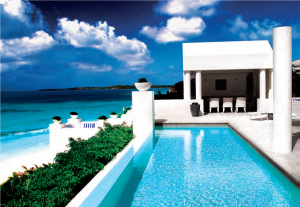 Architectural Digest, filled my laptop screen. What was not to love? Sea Villa overlooking Long Bay. A white stucco house sequestered by palm trees. A sparkling infinity pool bordered by white chaises heaped with brilliant blue pillows. Our very own private beach. The interior views were no less seductive. An acre of bed in the master bedroom with a white marble, sky-lit bathroom that was bigger than most peoples’ living rooms. Arching over all was the bluest of skies, dipping down to join an even bluer sea. “And the beauty of it is, a staff of three comes with the house. No cooking, no cleaning, breakfast in bed or by the pool or wherever you choose. Doug, this is one deal you can’t pass up. Next year,” he vowed. “We’ll all go.” It’s true I had to do a little strong-arming when I first broached the idea. From the kids came the usual protests: ski trips, Broadway tickets, parties of all kinds. But I held my ground. “Your cousins loved it,” I said. “We’re going to try it. How many more all-together family Christmases do we have?”
Architectural Digest, filled my laptop screen. What was not to love? Sea Villa overlooking Long Bay. A white stucco house sequestered by palm trees. A sparkling infinity pool bordered by white chaises heaped with brilliant blue pillows. Our very own private beach. The interior views were no less seductive. An acre of bed in the master bedroom with a white marble, sky-lit bathroom that was bigger than most peoples’ living rooms. Arching over all was the bluest of skies, dipping down to join an even bluer sea. “And the beauty of it is, a staff of three comes with the house. No cooking, no cleaning, breakfast in bed or by the pool or wherever you choose. Doug, this is one deal you can’t pass up. Next year,” he vowed. “We’ll all go.” It’s true I had to do a little strong-arming when I first broached the idea. From the kids came the usual protests: ski trips, Broadway tickets, parties of all kinds. But I held my ground. “Your cousins loved it,” I said. “We’re going to try it. How many more all-together family Christmases do we have?” sinful bliss.
sinful bliss.

 Steel plant in Pennsylvania, this was the strategy for attracting residents of Northern and Central New Jersey. Initially, the Sands had to market to New Jerseyans with the gaming-industry version of one hand tied behind its back. When the property first opened its doors in the spring of 2009, it offered no table games and the 302-room hotel was still on the drawing board. The license for table games came through that winter, at which point the company began constructing the hotel. It was completed this past spring— on budget and on time, a rarity in this business. With the 1996 demolition of the venerable Sands in Las Vegas, the Bethlehem operation is currently the only one in the U.S. that bears the Sands name. Walking into the Sands Bethlehem Casino Resort, you know you’re not in Vegas anymore. Amidst all the noise, light and energy, the casino manages to project a more relaxed, down-to-earth feel. According to Las Vegas Sands President and Chief Operating Officer Michael Leven, that was the plan from Day One. “We didn’t want to bring Las Vegas to the Lehigh Valley,” he explains. “No one’s betting $25,000 a hand here. We wanted something smaller and friendlier. The casino isn’t glitzy. It’s welcoming and comfortable. And the restaurants cover a wide range of price points.” Those restaurants are an important part of the draw. They include a traditional Irish pub, an outpost of New York’s Carnegie Deli, the requisite buffet, and three Emeril Lagasse creations—Emeril’s Chop House, Emeril’s Italian Table and BAM
Steel plant in Pennsylvania, this was the strategy for attracting residents of Northern and Central New Jersey. Initially, the Sands had to market to New Jerseyans with the gaming-industry version of one hand tied behind its back. When the property first opened its doors in the spring of 2009, it offered no table games and the 302-room hotel was still on the drawing board. The license for table games came through that winter, at which point the company began constructing the hotel. It was completed this past spring— on budget and on time, a rarity in this business. With the 1996 demolition of the venerable Sands in Las Vegas, the Bethlehem operation is currently the only one in the U.S. that bears the Sands name. Walking into the Sands Bethlehem Casino Resort, you know you’re not in Vegas anymore. Amidst all the noise, light and energy, the casino manages to project a more relaxed, down-to-earth feel. According to Las Vegas Sands President and Chief Operating Officer Michael Leven, that was the plan from Day One. “We didn’t want to bring Las Vegas to the Lehigh Valley,” he explains. “No one’s betting $25,000 a hand here. We wanted something smaller and friendlier. The casino isn’t glitzy. It’s welcoming and comfortable. And the restaurants cover a wide range of price points.” Those restaurants are an important part of the draw. They include a traditional Irish pub, an outpost of New York’s Carnegie Deli, the requisite buffet, and three Emeril Lagasse creations—Emeril’s Chop House, Emeril’s Italian Table and BAM , aka Burgers and More by Emeril. For nourishment on a budget, a food court offers everything from South Philly cheese steaks to pizza to pan-Asian fare, as well as some healthier choices. The next big thing for the Sands is a shopping mall that is slated to contain more than 30 retailers. It will be accessible directly from the casino floor. “Like other Sands properties, this is an integrated destination resort,” says Leven. “We’ll offer a lot of variety at this facility. There will be more than enough for non-players to do, but it will never be overwhelming. This is a nice town and we’ve built a nice place.” The rooms in the new hotel are terrific. Comfortable and understated, yet well-appointed, they are testament to the high precision with which casino people are able to match
, aka Burgers and More by Emeril. For nourishment on a budget, a food court offers everything from South Philly cheese steaks to pizza to pan-Asian fare, as well as some healthier choices. The next big thing for the Sands is a shopping mall that is slated to contain more than 30 retailers. It will be accessible directly from the casino floor. “Like other Sands properties, this is an integrated destination resort,” says Leven. “We’ll offer a lot of variety at this facility. There will be more than enough for non-players to do, but it will never be overwhelming. This is a nice town and we’ve built a nice place.” The rooms in the new hotel are terrific. Comfortable and understated, yet well-appointed, they are testament to the high precision with which casino people are able to match amenities with their target audience. Plenty of luxurious touches, but nothing over-the-top. The smallest room measures 400 square feet. All have 42-inch HD flat-screens, glass-enclosed showers and free in-room wireless access, and include a continental breakfast on the house. So who’s filling those rooms? When the property first opened, a little more than a third of the folks making the trek to Bethlehem were from North and Central New Jersey. Once table games were added, that number started climbing steadily—as did the number of players coming from New York City on a seemingly unbroken stream of back-and-forth buses. Not to say the slots aren’t active. On the contrary, the Sands took in $1 million more in July of 2011 than in July of 2010 from slot-machine play. Pulling New Jerseyans west from their bedroom communities is no mean feat. So far, so good on that account. Keeping them coming will be a constant challenge. There is competition from the south in Atlantic City— although it’s an additional hour’s drive—and, of course, the Big Apple beckons to the east. Long-term, it means offering more improvements and attractions to keep consumers and conventioneers coming. Of course, that’s always been part of the game plan. As Leven likes to say, “The status quo is a prescription for failure.”
amenities with their target audience. Plenty of luxurious touches, but nothing over-the-top. The smallest room measures 400 square feet. All have 42-inch HD flat-screens, glass-enclosed showers and free in-room wireless access, and include a continental breakfast on the house. So who’s filling those rooms? When the property first opened, a little more than a third of the folks making the trek to Bethlehem were from North and Central New Jersey. Once table games were added, that number started climbing steadily—as did the number of players coming from New York City on a seemingly unbroken stream of back-and-forth buses. Not to say the slots aren’t active. On the contrary, the Sands took in $1 million more in July of 2011 than in July of 2010 from slot-machine play. Pulling New Jerseyans west from their bedroom communities is no mean feat. So far, so good on that account. Keeping them coming will be a constant challenge. There is competition from the south in Atlantic City— although it’s an additional hour’s drive—and, of course, the Big Apple beckons to the east. Long-term, it means offering more improvements and attractions to keep consumers and conventioneers coming. Of course, that’s always been part of the game plan. As Leven likes to say, “The status quo is a prescription for failure.”
 wonder no more. We have removed the guesswork and narrowed the search. Presented here, for the very first time anywhere (that we known of anyway), is the bona fide dining guide to those neighborhood joints between Sandy Hook and Pt. Pleasant that locals swear by. Sure, you could peck away on the Internet and read all those planted reviews. Save yourself the trouble. The 60 “Shore Things” on this list are the real deal, with raves from real customers—trust us. Expect plenty of atmosphere, not too much ambiance. A few accept reservations, but most do not. Bon Appétit. EDGE
wonder no more. We have removed the guesswork and narrowed the search. Presented here, for the very first time anywhere (that we known of anyway), is the bona fide dining guide to those neighborhood joints between Sandy Hook and Pt. Pleasant that locals swear by. Sure, you could peck away on the Internet and read all those planted reviews. Save yourself the trouble. The 60 “Shore Things” on this list are the real deal, with raves from real customers—trust us. Expect plenty of atmosphere, not too much ambiance. A few accept reservations, but most do not. Bon Appétit. EDGE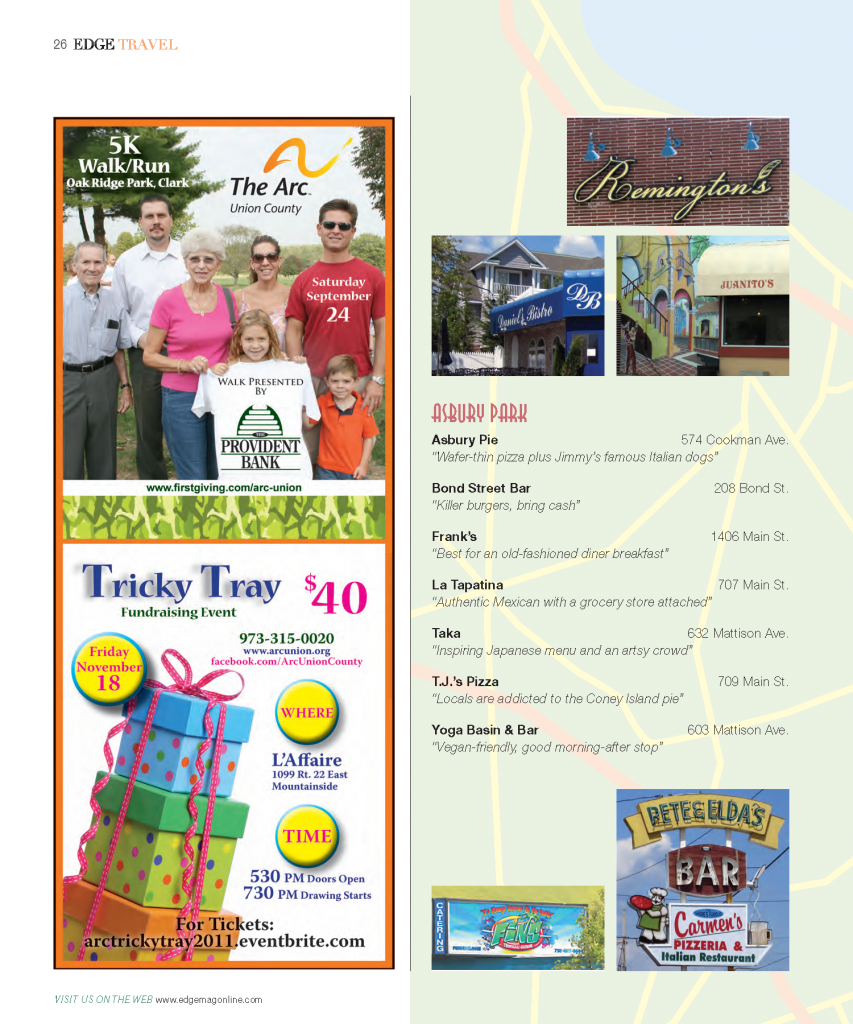



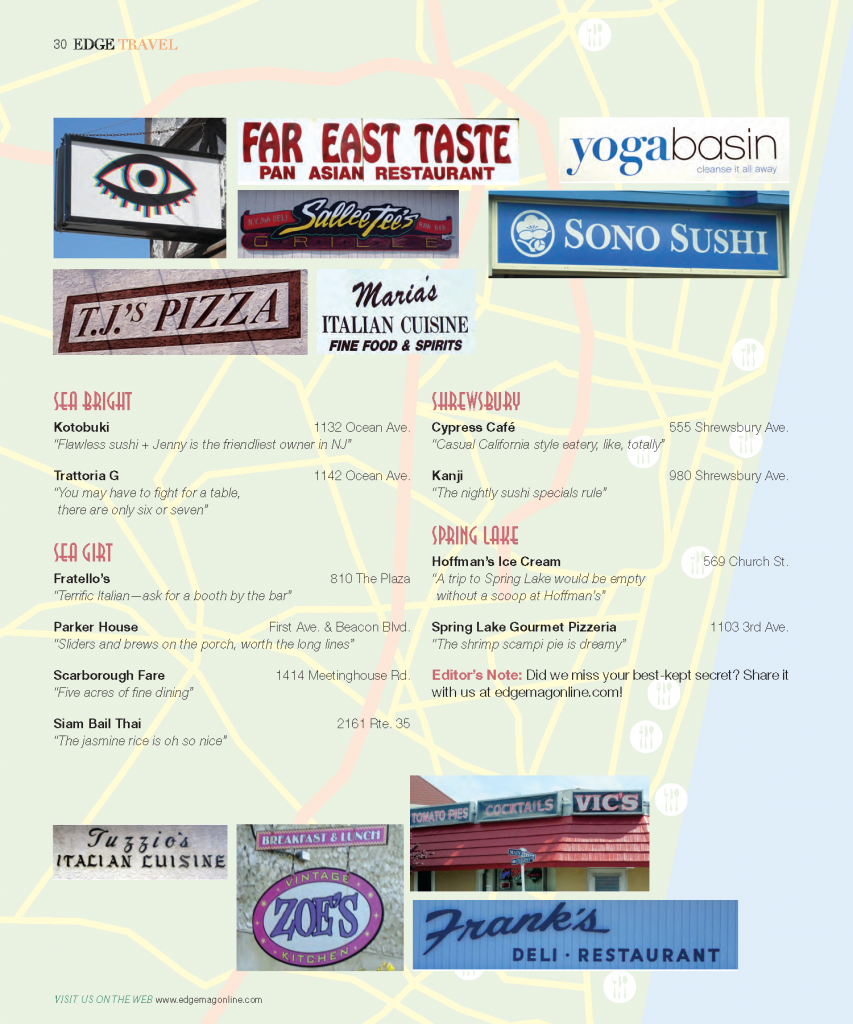
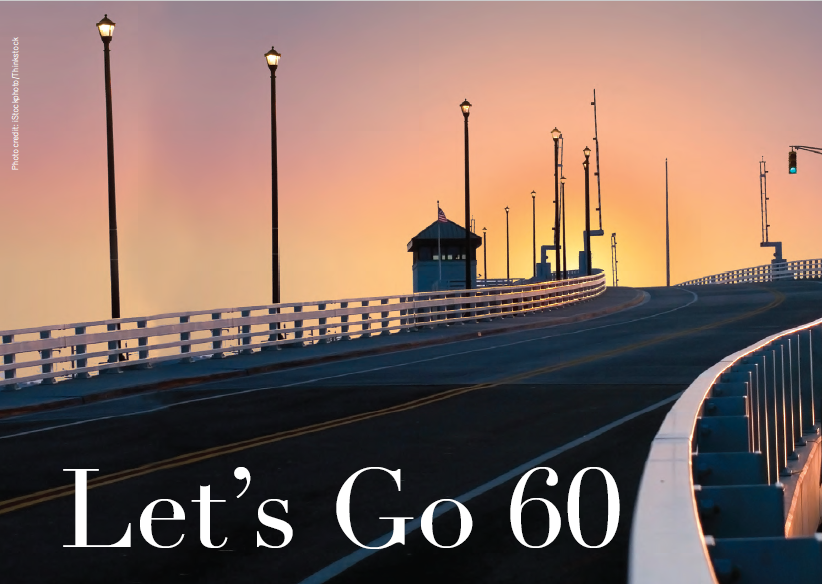
 will be noticeably lighter and you’ll feel like you just spent four hours in an overgrown cow pasture. That being said, Ken Wang isn’t your normal golf course owner. And Pound Ridge Golf Club in Westchester County is hardly your normal course. “It has a sublime rhythm,” says Wang, a married father of three sons, MIT grad and brother of famed fashion designer Vera Wang. “You remember every hole individually. The course has a certain harmony and serenity.” “May and June are beautiful here,” adds Todd Leavenworth, the general manager at Pound Ridge GC, “but you can’t beat the fall. That’s the best time of year for the course.” When Pound Ridge is green and lush, it’s a sight to behold. Designed by the legendary Pete Dye, the course is about 90 minutes away from Central New Jersey. It’s distinguished by unique rock formations and breathtaking views, including several of the Long Island Sound. In typical Dye fashion, there is an exquisite logic to the course, a quality that appeals to the mathematician in Wang. “It’s hard to pinpoint my favorite holes,” he says. “I love number 7, number 10 and number 11. They are gorgeous.” Leavenworth gushes about the par-3 15th hole known as Headstone. “It’s spectacular,” he says. “There is white marble behind the green that slopes at about a 20-degree pitch. You can actually hit to the marble and have the ball roll back toward the hole.” One feature of Pound Ridge GC that golfers of all levels love is the number of tees per hole—a staple of any
will be noticeably lighter and you’ll feel like you just spent four hours in an overgrown cow pasture. That being said, Ken Wang isn’t your normal golf course owner. And Pound Ridge Golf Club in Westchester County is hardly your normal course. “It has a sublime rhythm,” says Wang, a married father of three sons, MIT grad and brother of famed fashion designer Vera Wang. “You remember every hole individually. The course has a certain harmony and serenity.” “May and June are beautiful here,” adds Todd Leavenworth, the general manager at Pound Ridge GC, “but you can’t beat the fall. That’s the best time of year for the course.” When Pound Ridge is green and lush, it’s a sight to behold. Designed by the legendary Pete Dye, the course is about 90 minutes away from Central New Jersey. It’s distinguished by unique rock formations and breathtaking views, including several of the Long Island Sound. In typical Dye fashion, there is an exquisite logic to the course, a quality that appeals to the mathematician in Wang. “It’s hard to pinpoint my favorite holes,” he says. “I love number 7, number 10 and number 11. They are gorgeous.” Leavenworth gushes about the par-3 15th hole known as Headstone. “It’s spectacular,” he says. “There is white marble behind the green that slopes at about a 20-degree pitch. You can actually hit to the marble and have the ball roll back toward the hole.” One feature of Pound Ridge GC that golfers of all levels love is the number of tees per hole—a staple of any course designed by Dye. There are at least five tees on every hole, and some have six. “Pete is sensitive to the fact that all golfers don’t play at the same level,” says Wang. “When you play Pound Ridge from the correct tees, it’s a very enjoyable experience. The course is unusually fair to women.” There’s a good reason for that—Dye’s wife, Alice. The winner of nine Indiana Women’s Golf Association Amateur Championships, she has her husband’s ear every time he starts work on a new course. “Pound Ridge was a family affair,” says Wang. “Alice gets extremely involved whenever Pete is designing a course. She makes him more in touch with how women play the game.” “This is a really fun course for women,” he adds. “Probably more so than any other course I know.” Dye also puts a premium on exactitude. To score well at Pound Ridge GC, you have to hit the ball straight and the correct yardage. “The first time I played Pound Ridge, I felt like I had stepped into a math problem,” Wang recalls. “There’s an elegance to the course and artistry to the environment.” That’s a good way to describe the area surrounding Pound Ridge, as well. The closest neighboring towns are Bedford in New York and Greenwich and New Canaan in Connecticut. Close enough for a day trip, the surrounding area also offers enough to build a romantic weekend or ladies overnight around a round or two of golf. There are great restaurants, charming inns, lots of antique stores and all manner of shopping. Soon, says Wang, golfers at Pound Ridge GC won’t have to leave the course for a good meal. He has been working with architects on building a clubhouse. “It’s a funny project,” he says. “We’re talking about a ‘destination course’ in a residential area. We get local members and people flying in from London and Japan. We have several audiences to please.” With the current trend in clubhouse construction trending toward downsizing, Wang has shed his notions of what a traditional design looks like. Fortunately, he has a sister who knows a little bit about style. “Vera is pretty hip,” Wang says. “I defer to the higher power. She reminds me that the world isn’t filled with wood-panelled walls.” There’s always a chance that visitors to Pound Ridge GC will bump into Vera. According to Ken, she plays there several
course designed by Dye. There are at least five tees on every hole, and some have six. “Pete is sensitive to the fact that all golfers don’t play at the same level,” says Wang. “When you play Pound Ridge from the correct tees, it’s a very enjoyable experience. The course is unusually fair to women.” There’s a good reason for that—Dye’s wife, Alice. The winner of nine Indiana Women’s Golf Association Amateur Championships, she has her husband’s ear every time he starts work on a new course. “Pound Ridge was a family affair,” says Wang. “Alice gets extremely involved whenever Pete is designing a course. She makes him more in touch with how women play the game.” “This is a really fun course for women,” he adds. “Probably more so than any other course I know.” Dye also puts a premium on exactitude. To score well at Pound Ridge GC, you have to hit the ball straight and the correct yardage. “The first time I played Pound Ridge, I felt like I had stepped into a math problem,” Wang recalls. “There’s an elegance to the course and artistry to the environment.” That’s a good way to describe the area surrounding Pound Ridge, as well. The closest neighboring towns are Bedford in New York and Greenwich and New Canaan in Connecticut. Close enough for a day trip, the surrounding area also offers enough to build a romantic weekend or ladies overnight around a round or two of golf. There are great restaurants, charming inns, lots of antique stores and all manner of shopping. Soon, says Wang, golfers at Pound Ridge GC won’t have to leave the course for a good meal. He has been working with architects on building a clubhouse. “It’s a funny project,” he says. “We’re talking about a ‘destination course’ in a residential area. We get local members and people flying in from London and Japan. We have several audiences to please.” With the current trend in clubhouse construction trending toward downsizing, Wang has shed his notions of what a traditional design looks like. Fortunately, he has a sister who knows a little bit about style. “Vera is pretty hip,” Wang says. “I defer to the higher power. She reminds me that the world isn’t filled with wood-panelled walls.” There’s always a chance that visitors to Pound Ridge GC will bump into Vera. According to Ken, she plays there several times a year. “Vera is a pretty good player,” he says. “I’m probably better on the first ball, but she likes to throw down a second sometimes. She’s usually better on that one.” Ken’s sister isn’t the only celebrity who frequents the Pound Ridge area. Richard Gere, Susan Sarandon, Tim Robbins and Mike Myers are among those who claim residency in and around the town. Gere also owns a cozy place there, the Bedford Post Inn (above). While Wang prefers to stay out of the spotlight, he can’t deny the legacy he has created at Pound Ridge GC. “I didn’t use to think of it in those terms,” he says. “I started playing golf as a kid. The idea to buy the Pound Ridge property came after my father built a house in town in 1980. When we decided to turn the course into 18 holes, it took nine years to get all the approvals. Now we have a glamorous golf course that is very sensitive to the environment. It’s unlike any other course in the area. It’s nice to know that you’ve built something that will be around for a long while.” EDGE
times a year. “Vera is a pretty good player,” he says. “I’m probably better on the first ball, but she likes to throw down a second sometimes. She’s usually better on that one.” Ken’s sister isn’t the only celebrity who frequents the Pound Ridge area. Richard Gere, Susan Sarandon, Tim Robbins and Mike Myers are among those who claim residency in and around the town. Gere also owns a cozy place there, the Bedford Post Inn (above). While Wang prefers to stay out of the spotlight, he can’t deny the legacy he has created at Pound Ridge GC. “I didn’t use to think of it in those terms,” he says. “I started playing golf as a kid. The idea to buy the Pound Ridge property came after my father built a house in town in 1980. When we decided to turn the course into 18 holes, it took nine years to get all the approvals. Now we have a glamorous golf course that is very sensitive to the environment. It’s unlike any other course in the area. It’s nice to know that you’ve built something that will be around for a long while.” EDGE 
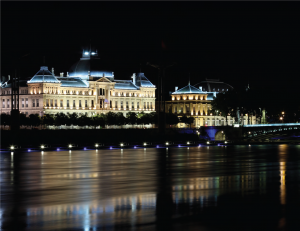 Silk, the fabric of kings and emperors—of nobility, popes and czars—has always signified wealth, prestige and luxury. Always? Probably, that is if you agree that a commodity cherished since 5000 B.C. merits such a term of longevity. Pharaohs dating back at least that far have been disentombed, their royal cadavers worshipfully swathed in silk. In ancient Rome, the wearing of silk was forbidden the ordinary citizen. Only members of the imperial family could appear in public wearing it. In Europe, by the 15th century, the French city of Lyon was calling itself the Silk Capital of the World.
Silk, the fabric of kings and emperors—of nobility, popes and czars—has always signified wealth, prestige and luxury. Always? Probably, that is if you agree that a commodity cherished since 5000 B.C. merits such a term of longevity. Pharaohs dating back at least that far have been disentombed, their royal cadavers worshipfully swathed in silk. In ancient Rome, the wearing of silk was forbidden the ordinary citizen. Only members of the imperial family could appear in public wearing it. In Europe, by the 15th century, the French city of Lyon was calling itself the Silk Capital of the World.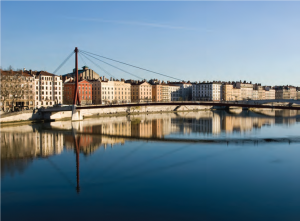 How justified was that claim? Well, when that bit of braggadocio first surfaced, it’s more than possible that China, Korea, India and who knows what other kingdoms might well have challenged Lyon for the title. But today, in the rarefied world of haute couture, Lyon with its silken boast, is right on the money. A city of half a million, Lyon is situated between two rivers: the fast-flowing Rhone and the gently flowing Soane, both passing the city, southbound to the Mediterranean. Of its long and proud history, suffice it to say that it once was the capital of Gaul and often visited by more than one Emperor. In the last two or three years, the traboules of Lyon, those 18th-century covered passageways that crisscross the silk workers’ district, have seen a virtual stampede of designers and couturiers. They fly in from Milan, New York, Tokyo and all points in between. Their names read like a celestial roll call in the paradise of high fashion. Dior, Lanvin, Chanel, Versace, Vera Wang. They come intent on securing exclusivity, or the nearest thing thereto, on the exquisite fabrics that spill forth from the looms of Lyon. Silk, which never ever was out, is now more than ever in. From the silk-wrapped heels of shoes by Dries van Noten to the extravagant ruffles of Lanvin’s evening wear, the word is SILK. Contradicting everything that fashion pundits know about trend, style and fad, silk retains its hold on elegance even while it also successfully teams up with jeans, beach wear and the most casual of the casual. Not possible! Yet true. Lyon owes much of its silky prestige to François I, the first Renaissance king to grace the French throne. A major patron of the arts and a great admirer of Italian style and elegance, he was determined to see France surpass Italy in all artistic endeavors. To that end he persuaded the great Leonardo da Vinci to quit his native Tuscany and come to live in France. Leonardo packed up bag and baggage, tucking into his luggage his favorite opus, “La Gioconda” (aka Mona Lisa). After he died in 1519, cradled in the arms of a weeping King François, that masterpiece became French property. Today it hangs in the Louvre in Paris where, as a touristic attraction, it ranks second only to the Eiffel Tower. Apart from luring Leonardo and his Mona Lisa to France, Francois I also determined that the weavers of Lyon, specialists i
How justified was that claim? Well, when that bit of braggadocio first surfaced, it’s more than possible that China, Korea, India and who knows what other kingdoms might well have challenged Lyon for the title. But today, in the rarefied world of haute couture, Lyon with its silken boast, is right on the money. A city of half a million, Lyon is situated between two rivers: the fast-flowing Rhone and the gently flowing Soane, both passing the city, southbound to the Mediterranean. Of its long and proud history, suffice it to say that it once was the capital of Gaul and often visited by more than one Emperor. In the last two or three years, the traboules of Lyon, those 18th-century covered passageways that crisscross the silk workers’ district, have seen a virtual stampede of designers and couturiers. They fly in from Milan, New York, Tokyo and all points in between. Their names read like a celestial roll call in the paradise of high fashion. Dior, Lanvin, Chanel, Versace, Vera Wang. They come intent on securing exclusivity, or the nearest thing thereto, on the exquisite fabrics that spill forth from the looms of Lyon. Silk, which never ever was out, is now more than ever in. From the silk-wrapped heels of shoes by Dries van Noten to the extravagant ruffles of Lanvin’s evening wear, the word is SILK. Contradicting everything that fashion pundits know about trend, style and fad, silk retains its hold on elegance even while it also successfully teams up with jeans, beach wear and the most casual of the casual. Not possible! Yet true. Lyon owes much of its silky prestige to François I, the first Renaissance king to grace the French throne. A major patron of the arts and a great admirer of Italian style and elegance, he was determined to see France surpass Italy in all artistic endeavors. To that end he persuaded the great Leonardo da Vinci to quit his native Tuscany and come to live in France. Leonardo packed up bag and baggage, tucking into his luggage his favorite opus, “La Gioconda” (aka Mona Lisa). After he died in 1519, cradled in the arms of a weeping King François, that masterpiece became French property. Today it hangs in the Louvre in Paris where, as a touristic attraction, it ranks second only to the Eiffel Tower. Apart from luring Leonardo and his Mona Lisa to France, Francois I also determined that the weavers of Lyon, specialists i n the secrets of silk-making, should be elevated to the front ranks of French commerce. To accomplish his objective he opened the royal purse strings to attract Europe’s finest weavers. Before his reign ended in 1547, Lyon was acknowledged as the primary source for the finest silks the world had ever seen. For the next 300 years, the weavers of Lyon thrived, lodged in high-ceilinged buildings, designed to accommodate their huge hand-operated looms. Today the looms of Lyon are high-tech marvels, controlled by computers. But in the section known as Croix Rouge, a handful of the ancient looms remain. To the delight of tourists, the weavers perform their ancient rites, still turning out priceless yardage. Few who watch the process escape a visit to the adjoining gift shops, all amply stocked with scarves, shawls, ties, skirts, shirts, purses, bedding, all of course of priceless silk. “I use silk in every one of my collections,” says Andrew Gn, the Singapore-born, Paris-based designer whose highfashion creations are carried by Bergdorf Goodman. “Silk drapes much better than anything else…and the contact of silk with skin is irreplaceable.” In his forthcoming Spring/Summer 2011 collection, Gn uses a magnificent triple-silk crepe, specially woven for his atelier. As he puts it, “Silk translates colors much better; it makes them extremely rich.” His clientele consists in large part of individuals seeking one of- a-kind creations which can be worn in the sure knowledge that her choice will not be replicated. (It’s an assurance that doesn’t come at bargain prices!) Monsieur Gn’s clientele, which includes a healthy smattering of royalty and easily-recognized names from the world of diplomats and heads of state, professes fierce loyalty to their designer of choice. Simply put, “He’s a genius,” was the gratuitous observation by an obviously satisfied client. For Andre Claude Canova, a passion for the silks of Lyon began more than a quarter of a century ago. Today he designs his own collection, which includes the most exquisite silk scarves—some of which encompass as many as 15 or 20 different colors, an achievement unequalled by any other designer. His studio at 26 Quai St.Vincent in the heart of Lyon is an old Carthusian residence, its entrance a handsome horseshoe-shaped Renaissance staircase. Favored buyers are received in its superbly furnished salons, the walls lined with…what else? Pure silk. The ambience is unmistakably Old World but the scarves, vests, pillows and jackets are on the very cutting edge. His own special design of scarf suspenders created a minor tsunami in the world of fashion when they first appeared. Supermodel Jerry Hall was so enchanted with them that she ordered 20 pairs. Princess Caroline of Monaco is frequently photographed in them and when the G-7 convened in Lyon, Bill and Hillary were delighted to be presented with a selection of Canova scarf-suspenders. An undoubted original, Andre Claude-Canova, when asked the source of his creative inspirations, replied, “Travel, history, nature.” He went on, “It can be a sunset in Tuscany, the masks of the Maasai, the silky pearl shades of a Maharajah’s robes, or the jewels of the Taj Mahal…” But the one constant in all of his creations is silk, woven in an unmatched panoply of colors. The distinction of being the oldest silk factory in Lyon belongs to Prelle et Cie, which has been in continuous operation since 1752 and is owned today by direct descendents of its founders. Apart from its stylish contemporary output of scarves, ties, shawls and other pieces, Prelle has proven invaluable in the rarefied world of authentic restoration of palaces and castles, historical houses and public places. It counts among its restorative masterpieces the authentic recreation of the silk brocades used in the Royal Bedchamber of the Sun King, Louis XIV, at Versailles, the draperies and upholstered pieces at Biltmore in North Carolina and at Ash Lawn, the ancestral home in Virginia of James Monroe. Such historical replication of two- and three-hundred-yearold fabrics is possible thanks in part to the exquisite workmanship of the Prelle artisans, and in part to the company’s scrupulously maintained archives, which date back four centuries.
n the secrets of silk-making, should be elevated to the front ranks of French commerce. To accomplish his objective he opened the royal purse strings to attract Europe’s finest weavers. Before his reign ended in 1547, Lyon was acknowledged as the primary source for the finest silks the world had ever seen. For the next 300 years, the weavers of Lyon thrived, lodged in high-ceilinged buildings, designed to accommodate their huge hand-operated looms. Today the looms of Lyon are high-tech marvels, controlled by computers. But in the section known as Croix Rouge, a handful of the ancient looms remain. To the delight of tourists, the weavers perform their ancient rites, still turning out priceless yardage. Few who watch the process escape a visit to the adjoining gift shops, all amply stocked with scarves, shawls, ties, skirts, shirts, purses, bedding, all of course of priceless silk. “I use silk in every one of my collections,” says Andrew Gn, the Singapore-born, Paris-based designer whose highfashion creations are carried by Bergdorf Goodman. “Silk drapes much better than anything else…and the contact of silk with skin is irreplaceable.” In his forthcoming Spring/Summer 2011 collection, Gn uses a magnificent triple-silk crepe, specially woven for his atelier. As he puts it, “Silk translates colors much better; it makes them extremely rich.” His clientele consists in large part of individuals seeking one of- a-kind creations which can be worn in the sure knowledge that her choice will not be replicated. (It’s an assurance that doesn’t come at bargain prices!) Monsieur Gn’s clientele, which includes a healthy smattering of royalty and easily-recognized names from the world of diplomats and heads of state, professes fierce loyalty to their designer of choice. Simply put, “He’s a genius,” was the gratuitous observation by an obviously satisfied client. For Andre Claude Canova, a passion for the silks of Lyon began more than a quarter of a century ago. Today he designs his own collection, which includes the most exquisite silk scarves—some of which encompass as many as 15 or 20 different colors, an achievement unequalled by any other designer. His studio at 26 Quai St.Vincent in the heart of Lyon is an old Carthusian residence, its entrance a handsome horseshoe-shaped Renaissance staircase. Favored buyers are received in its superbly furnished salons, the walls lined with…what else? Pure silk. The ambience is unmistakably Old World but the scarves, vests, pillows and jackets are on the very cutting edge. His own special design of scarf suspenders created a minor tsunami in the world of fashion when they first appeared. Supermodel Jerry Hall was so enchanted with them that she ordered 20 pairs. Princess Caroline of Monaco is frequently photographed in them and when the G-7 convened in Lyon, Bill and Hillary were delighted to be presented with a selection of Canova scarf-suspenders. An undoubted original, Andre Claude-Canova, when asked the source of his creative inspirations, replied, “Travel, history, nature.” He went on, “It can be a sunset in Tuscany, the masks of the Maasai, the silky pearl shades of a Maharajah’s robes, or the jewels of the Taj Mahal…” But the one constant in all of his creations is silk, woven in an unmatched panoply of colors. The distinction of being the oldest silk factory in Lyon belongs to Prelle et Cie, which has been in continuous operation since 1752 and is owned today by direct descendents of its founders. Apart from its stylish contemporary output of scarves, ties, shawls and other pieces, Prelle has proven invaluable in the rarefied world of authentic restoration of palaces and castles, historical houses and public places. It counts among its restorative masterpieces the authentic recreation of the silk brocades used in the Royal Bedchamber of the Sun King, Louis XIV, at Versailles, the draperies and upholstered pieces at Biltmore in North Carolina and at Ash Lawn, the ancestral home in Virginia of James Monroe. Such historical replication of two- and three-hundred-yearold fabrics is possible thanks in part to the exquisite workmanship of the Prelle artisans, and in part to the company’s scrupulously maintained archives, which date back four centuries. Patterns, hand-drawn in quill and ink, with color samples provided in watercolor paints—their intricate designs sketched in painstaking detail and selected for use in palaces, stately homes, public halls—were recorded and filed. Thus modern-day restorers are able to see exactly what designs and what colors were used in specific venues centuries past. No other silk weaving establishment anywhere in the world can claim as much. In addition to its French premises, Prelle also maintains a showroom in New York at 43 E. 10th Street. Apart from its gilded salons and showrooms frequented by the world’s top designers, Lyon has more than its fair share of stylish boutiques. All along the Rue de la Republique (incidentally, the longest pedestrian street in France), the very latest trends are fetchingly displayed in shop windows. Come early December, Lyon celebrates the Festival of Lights. For one glorious week the town is lighted throughout the night. Music seems to pour from every doorway; mimes, jugglers and troupes of musicians are everywhere. It’s as if the whole city was tripping out on some incredible potion. The restaurants—1,000 of them at last count—do a landslide business, for gastronomy in Lyon is a source of huge civic pride. It’s not for nothing that Lyon is often called the “best-fed” city in France. When I repeated the epitaph to a Lyonnais, he quickly put me straight: “The best-fed city not in France, but in Europe!” So much for local modesty. Then again, it’s no mere coincidence that Paul Bocuse, the high priest of French gastronomy, chooses to live in Lyon, where he presides over two restaurants. A world famous chef who actually cooks? It sounds ordinary enough, but in the tippy-top layers of prize-winning, globally-acclaimed chefs, it’s rare enough to elicit expressions of wonder from fellow chefs. A final word of advice. Don’t journey to the city in search of bargains. It’s doubtful that Lyon even knows the meaning of the word. But if it’s quality you seek, if it’s the full value of every Euro spent, then quite definitely, Lyon may be just the city for you.
Patterns, hand-drawn in quill and ink, with color samples provided in watercolor paints—their intricate designs sketched in painstaking detail and selected for use in palaces, stately homes, public halls—were recorded and filed. Thus modern-day restorers are able to see exactly what designs and what colors were used in specific venues centuries past. No other silk weaving establishment anywhere in the world can claim as much. In addition to its French premises, Prelle also maintains a showroom in New York at 43 E. 10th Street. Apart from its gilded salons and showrooms frequented by the world’s top designers, Lyon has more than its fair share of stylish boutiques. All along the Rue de la Republique (incidentally, the longest pedestrian street in France), the very latest trends are fetchingly displayed in shop windows. Come early December, Lyon celebrates the Festival of Lights. For one glorious week the town is lighted throughout the night. Music seems to pour from every doorway; mimes, jugglers and troupes of musicians are everywhere. It’s as if the whole city was tripping out on some incredible potion. The restaurants—1,000 of them at last count—do a landslide business, for gastronomy in Lyon is a source of huge civic pride. It’s not for nothing that Lyon is often called the “best-fed” city in France. When I repeated the epitaph to a Lyonnais, he quickly put me straight: “The best-fed city not in France, but in Europe!” So much for local modesty. Then again, it’s no mere coincidence that Paul Bocuse, the high priest of French gastronomy, chooses to live in Lyon, where he presides over two restaurants. A world famous chef who actually cooks? It sounds ordinary enough, but in the tippy-top layers of prize-winning, globally-acclaimed chefs, it’s rare enough to elicit expressions of wonder from fellow chefs. A final word of advice. Don’t journey to the city in search of bargains. It’s doubtful that Lyon even knows the meaning of the word. But if it’s quality you seek, if it’s the full value of every Euro spent, then quite definitely, Lyon may be just the city for you.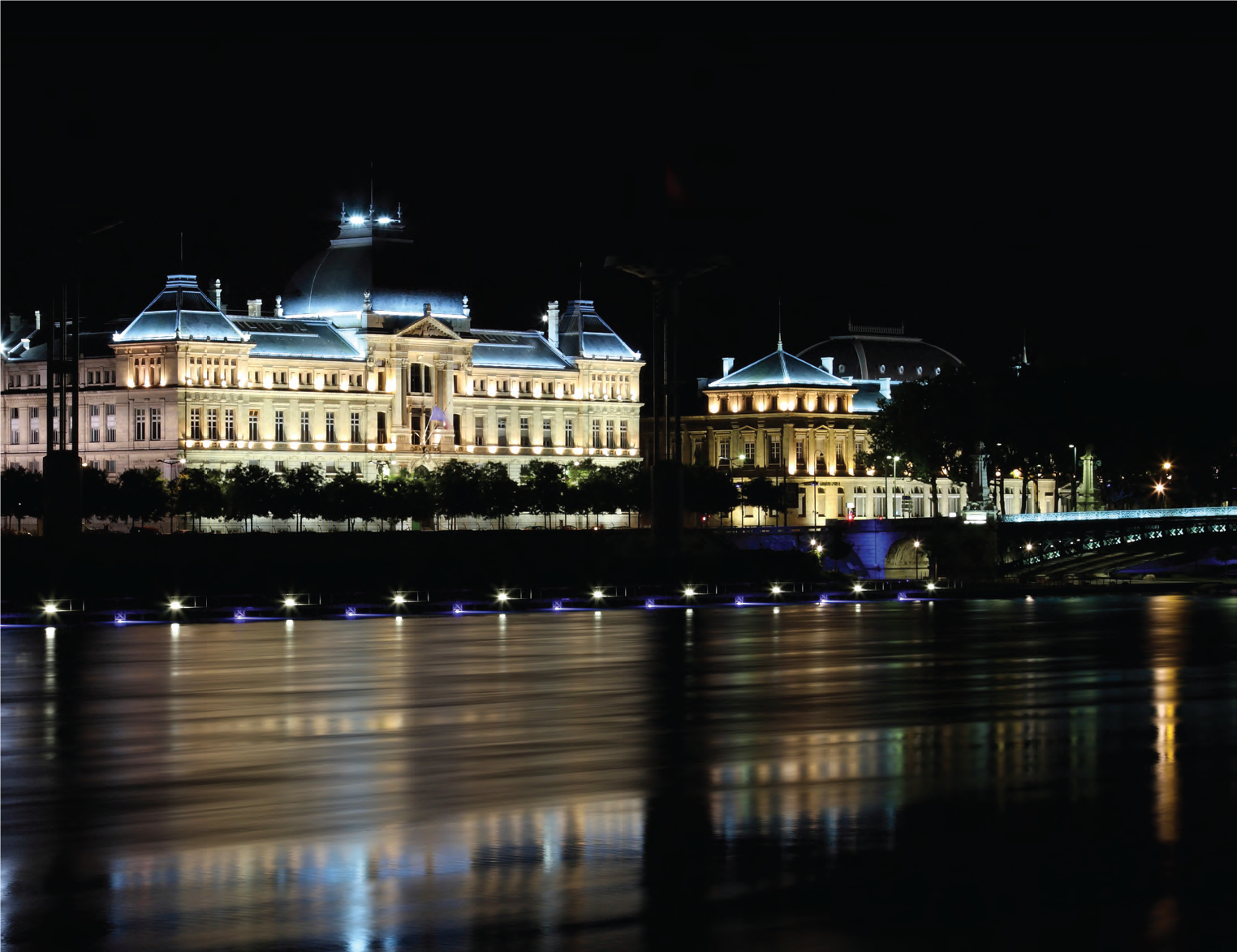
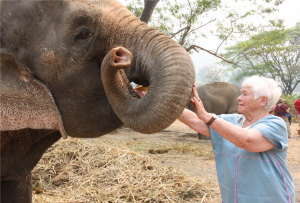 As a child I had no interest in Nancy Drew, or Jo of Little Women. Pippi Longstocking had yet to appear, but even had she arrived a few decades sooner, I’m sure I would have ignored her as well. For me, the very center of my imaginary world was Toomai the Elephant Boy. Toomai of the Elephants was just one of Rudyard Kipling’s marvelous contributions to childhood. Along with millions of other children in any of 70 languages, I was hooked by the Just So Stories in general, by Toomai in particular. Toomai who bullied his elephant. Who shouted commands and stamped his bare foot when his elephant dared not to obey him on the instant.
As a child I had no interest in Nancy Drew, or Jo of Little Women. Pippi Longstocking had yet to appear, but even had she arrived a few decades sooner, I’m sure I would have ignored her as well. For me, the very center of my imaginary world was Toomai the Elephant Boy. Toomai of the Elephants was just one of Rudyard Kipling’s marvelous contributions to childhood. Along with millions of other children in any of 70 languages, I was hooked by the Just So Stories in general, by Toomai in particular. Toomai who bullied his elephant. Who shouted commands and stamped his bare foot when his elephant dared not to obey him on the instant. 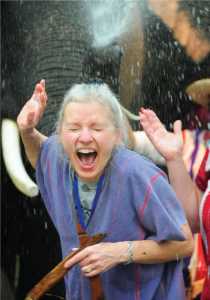 Atop his elephant, Toomai rode fearlessly through the jungles of India. Together, child and beast were impervious to all authority of his elders. Toomai and his elephant. The stuff of dreams! So it was that when I first read about Patara Farm in Thailand—and its program entitled “Own an Elephant for a Day”—I knew I had no choice. Patara Farm is located about an hour’s jeep ride outside of Chiang Mai in Northern Thailand. The owner of the farm and the inspiration for the program is a soft-spoken, 37-year-old conservationist, named Theerapat Trungprakan. (“Please, just call me Pat.”) My day of elephant ownership begins in the cool of the morning. Along with seven other would-be elephant owners (groups are limited to eight), I arrive at the 100-acre property carved out of lush woodlands and tropical verdure. Patara is home for Pat, his wife, Dow, three very young sons and 28 elephants. It’s a huge undertaking. To help him, Pat has a staff of 18 local boys, one of whom leads us from the road where our jeeps were parked, along an improvised narrow boardwalk, across a stretch of marsh to a thatched shelter, where Pat greets us. Every inch the attentive host, Pat ushers us to seats on hand-hewn benches. As we help ourselves to fruits and juices, he introduces himself and his life’s work, beginning by sketching for us the story of how elephants were domesticated 2,500 years ago in India, where they were first captured in the wild, tamed and trained. Generation after generation of these massive mammals were bred for docility, agility and robust health. The art—and what an art it is!—of training an elephant for a lifetime of productive work was handed down, father-to-son, and about 500 years ago was passed from India to Thailand. Pat tosses in a few elephant facts: An elephant has a life span of 60 to 70 years.
Atop his elephant, Toomai rode fearlessly through the jungles of India. Together, child and beast were impervious to all authority of his elders. Toomai and his elephant. The stuff of dreams! So it was that when I first read about Patara Farm in Thailand—and its program entitled “Own an Elephant for a Day”—I knew I had no choice. Patara Farm is located about an hour’s jeep ride outside of Chiang Mai in Northern Thailand. The owner of the farm and the inspiration for the program is a soft-spoken, 37-year-old conservationist, named Theerapat Trungprakan. (“Please, just call me Pat.”) My day of elephant ownership begins in the cool of the morning. Along with seven other would-be elephant owners (groups are limited to eight), I arrive at the 100-acre property carved out of lush woodlands and tropical verdure. Patara is home for Pat, his wife, Dow, three very young sons and 28 elephants. It’s a huge undertaking. To help him, Pat has a staff of 18 local boys, one of whom leads us from the road where our jeeps were parked, along an improvised narrow boardwalk, across a stretch of marsh to a thatched shelter, where Pat greets us. Every inch the attentive host, Pat ushers us to seats on hand-hewn benches. As we help ourselves to fruits and juices, he introduces himself and his life’s work, beginning by sketching for us the story of how elephants were domesticated 2,500 years ago in India, where they were first captured in the wild, tamed and trained. Generation after generation of these massive mammals were bred for docility, agility and robust health. The art—and what an art it is!—of training an elephant for a lifetime of productive work was handed down, father-to-son, and about 500 years ago was passed from India to Thailand. Pat tosses in a few elephant facts: An elephant has a life span of 60 to 70 years.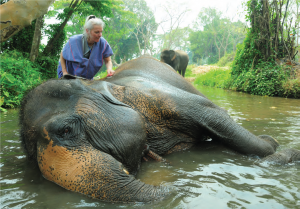 Female elephants often give birth right up through the age of 50. A newborn weighs in at about 260 pounds, delivered after 22 months of gestation. A full-grown elephant can weigh as much as 11,000 pounds and will stand as high as 10 feet at the shoulder. Elephants are herbivores, who every day pack away 350 to 400 pounds of plant material. Sugar cane and bananas rank high on their list of Favorite Foods. As we listen, we gaze out into the surrounding woodlands, where elephants stroll by at their leisure, thoughtfully munching untidy mouthfuls of shrubbery. The warm, moist air carries a strong animal musk. It smells marvelous. It bespeaks nature unbounded. Nature in the raw; somehow it conveys an elemental certainty. It’s as if, however briefly, we are transported beyond the trivia, the excess and, yes, the absurdity of human events into a realm of uncorrupted truth. To call Pat impassioned on the subject of elephants is a massive understatement. His understanding of these extraordinary animals is exceeded only by the love and respect he bears them. He tells us that there was a time when elephants roamed vast areas of Asia and Africa— before man made fire, before man stood upright, before farmers farmed. Their numbers were legion.
Female elephants often give birth right up through the age of 50. A newborn weighs in at about 260 pounds, delivered after 22 months of gestation. A full-grown elephant can weigh as much as 11,000 pounds and will stand as high as 10 feet at the shoulder. Elephants are herbivores, who every day pack away 350 to 400 pounds of plant material. Sugar cane and bananas rank high on their list of Favorite Foods. As we listen, we gaze out into the surrounding woodlands, where elephants stroll by at their leisure, thoughtfully munching untidy mouthfuls of shrubbery. The warm, moist air carries a strong animal musk. It smells marvelous. It bespeaks nature unbounded. Nature in the raw; somehow it conveys an elemental certainty. It’s as if, however briefly, we are transported beyond the trivia, the excess and, yes, the absurdity of human events into a realm of uncorrupted truth. To call Pat impassioned on the subject of elephants is a massive understatement. His understanding of these extraordinary animals is exceeded only by the love and respect he bears them. He tells us that there was a time when elephants roamed vast areas of Asia and Africa— before man made fire, before man stood upright, before farmers farmed. Their numbers were legion.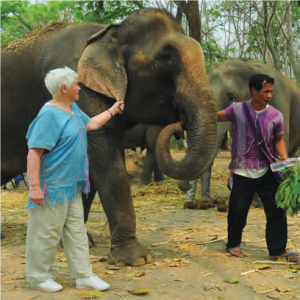 Today, it is estimated that in the whole world there are probably no more than 52,000 left in the wild. Every passing year sees their numbers decline. Where once they were used as beasts of burden, as transport, as invaluable aids in forestry, in heavy labor of every kind, today they are used only in ceremonial pageants and in a few instances as tourist attractions. “In 20 years, maybe less, elephants could become extinct. Except in a zoo, they will cease to exist.” Pat pauses, then resumes. “Extinction,” he tells us, “is forever.” He turns and we read those very words on the back of his bright red Tshirt. Each of us is paired up with an elephant. Ours for the day. I’m introduced to Nui, a 14-year old female. Tethered by one massive leg she stands in the shade of a giant mango tree. I approach with delight generously mixed with total ignorance. Meet a dog, hold out your open palm. Meet a horse, speak softly, move slowly, stroke the neck and muzzle. But meet an elephant? Toomai, help me! I reach up and run my hand over the crinkly skin.
Today, it is estimated that in the whole world there are probably no more than 52,000 left in the wild. Every passing year sees their numbers decline. Where once they were used as beasts of burden, as transport, as invaluable aids in forestry, in heavy labor of every kind, today they are used only in ceremonial pageants and in a few instances as tourist attractions. “In 20 years, maybe less, elephants could become extinct. Except in a zoo, they will cease to exist.” Pat pauses, then resumes. “Extinction,” he tells us, “is forever.” He turns and we read those very words on the back of his bright red Tshirt. Each of us is paired up with an elephant. Ours for the day. I’m introduced to Nui, a 14-year old female. Tethered by one massive leg she stands in the shade of a giant mango tree. I approach with delight generously mixed with total ignorance. Meet a dog, hold out your open palm. Meet a horse, speak softly, move slowly, stroke the neck and muzzle. But meet an elephant? Toomai, help me! I reach up and run my hand over the crinkly skin.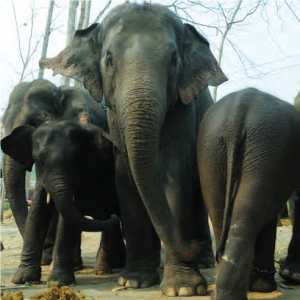 Surprise! It’s covered with short, black, bristly hairs that are all but invisible unless you’re standing very close. She’s so big that even on tiptoe I can hardly reach higher than her eyes. By way of introduction I feed her about 20 pounds of corn cobs and sugarcane stalks provided by Tang, one of Pat’s helpers. It’s a tricky business, because each offering has to be poked directly into her mouth, which is obstructed by her trunk which curls and uncurls in unpredictable ways. “Good Nui,” I tell her, “good girl,” forgetting that though English is my language, her language is Thai. As the sun climbs toward the zenith of noon, Pat shows us how to command our elephants to lie down in order to sweep their backs free of dirt, leaves and twigs with a fistful of palm fronds. Once tidied up, I offer Nui the palm fronds, which she consumes in a single messy mouthful. Bath time! The approved technique by which one moves one’s elephant out from under a mango tree down to the river some 200 yards away consists of taking a firm grip on the edge of one ear and telling her “My-my-my-my,” the Thai word for “Come.” Slowly but surely, we progress to the river’s edge. There I release my hold, step aside and Nui wades in to join the other seven elephants. It’s playtime. With much swooshing and spraying, much splashing and squirting, all the elephants—along with their owners-for-the day—have a watery free-for-all.
Surprise! It’s covered with short, black, bristly hairs that are all but invisible unless you’re standing very close. She’s so big that even on tiptoe I can hardly reach higher than her eyes. By way of introduction I feed her about 20 pounds of corn cobs and sugarcane stalks provided by Tang, one of Pat’s helpers. It’s a tricky business, because each offering has to be poked directly into her mouth, which is obstructed by her trunk which curls and uncurls in unpredictable ways. “Good Nui,” I tell her, “good girl,” forgetting that though English is my language, her language is Thai. As the sun climbs toward the zenith of noon, Pat shows us how to command our elephants to lie down in order to sweep their backs free of dirt, leaves and twigs with a fistful of palm fronds. Once tidied up, I offer Nui the palm fronds, which she consumes in a single messy mouthful. Bath time! The approved technique by which one moves one’s elephant out from under a mango tree down to the river some 200 yards away consists of taking a firm grip on the edge of one ear and telling her “My-my-my-my,” the Thai word for “Come.” Slowly but surely, we progress to the river’s edge. There I release my hold, step aside and Nui wades in to join the other seven elephants. It’s playtime. With much swooshing and spraying, much splashing and squirting, all the elephants—along with their owners-for-the day—have a watery free-for-all.  Pat and his helpers provide us with buckets and scrub brushes; when our charges lie down, we are shown how to baste them and scrub them, an exercise which Nui and I enjoy in equal measure. At last, my Toomai moment arrives! It’s time to climb on board. Pat demonstrates four different ways of handling it. As I recall, Toomai would say the word and his elephant would wrap his trunk around him and lift him onto his head. But that method is not included in the four styles we are shown. I choose what appears to be the easiest and in so doing, I find there is no “easy” (much less “easiest”). Still, I make it onto Nui’s head by standing on her curled front leg and hauling myself up by shamelessly using her ear as a handhold. Once seated, Toomai-like, I tuck my bare feet one foot behind each ear, and speak the magic words that Nui clearly understands. It’s “Sai” for left and “Kwa” for right. We fall into parade formation and, with Pat in the lead, we make our way, slowly and stately, through a mile or so of woodlands from which we emerge in a glen into which tumbles a sparkling waterfall—the perfect antidote for Thailand’s torrid temperatures. A delectable picnic lunch of unidentifiable Thai dishes has been laid out for us atop layers of banana leaves. While we set to, our elephants gambol in the water, shooting trunksful of water at each other, not caring one whit if they soak their owners in the process. It’s late afternoon by the time we make our way back to Patara Farm. I’m soaked, exhausted, exhilarated. Nui and I have bonded. She kneels down so I can slither off her and in farewell I stroke her trunk, whispering endearments. “Lah gorn, Nui” I tell her. Remembering my Kipling, I know full well that Nui will never forget me. It goes without saying that I will never forget Nui. We bid Pat farewell. Our group heads for the jeeps and I think to myself, Well, Toomai, at long last, I made it! EDGE
Pat and his helpers provide us with buckets and scrub brushes; when our charges lie down, we are shown how to baste them and scrub them, an exercise which Nui and I enjoy in equal measure. At last, my Toomai moment arrives! It’s time to climb on board. Pat demonstrates four different ways of handling it. As I recall, Toomai would say the word and his elephant would wrap his trunk around him and lift him onto his head. But that method is not included in the four styles we are shown. I choose what appears to be the easiest and in so doing, I find there is no “easy” (much less “easiest”). Still, I make it onto Nui’s head by standing on her curled front leg and hauling myself up by shamelessly using her ear as a handhold. Once seated, Toomai-like, I tuck my bare feet one foot behind each ear, and speak the magic words that Nui clearly understands. It’s “Sai” for left and “Kwa” for right. We fall into parade formation and, with Pat in the lead, we make our way, slowly and stately, through a mile or so of woodlands from which we emerge in a glen into which tumbles a sparkling waterfall—the perfect antidote for Thailand’s torrid temperatures. A delectable picnic lunch of unidentifiable Thai dishes has been laid out for us atop layers of banana leaves. While we set to, our elephants gambol in the water, shooting trunksful of water at each other, not caring one whit if they soak their owners in the process. It’s late afternoon by the time we make our way back to Patara Farm. I’m soaked, exhausted, exhilarated. Nui and I have bonded. She kneels down so I can slither off her and in farewell I stroke her trunk, whispering endearments. “Lah gorn, Nui” I tell her. Remembering my Kipling, I know full well that Nui will never forget me. It goes without saying that I will never forget Nui. We bid Pat farewell. Our group heads for the jeeps and I think to myself, Well, Toomai, at long last, I made it! EDGE 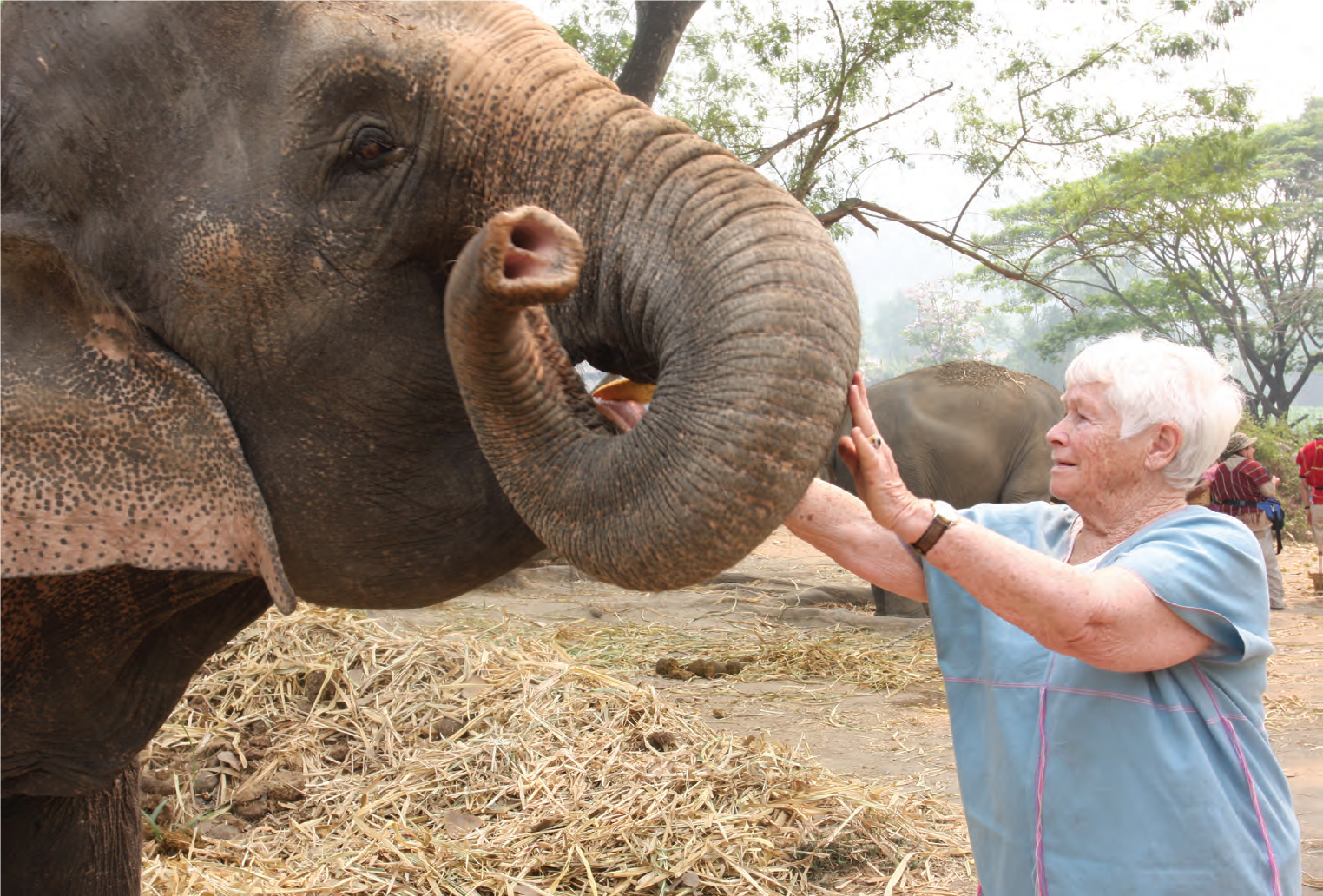
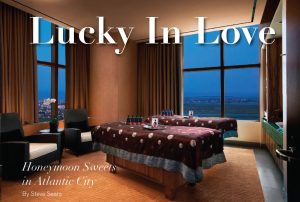

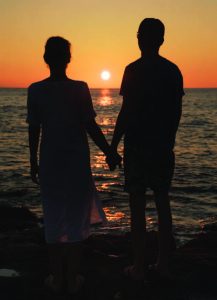
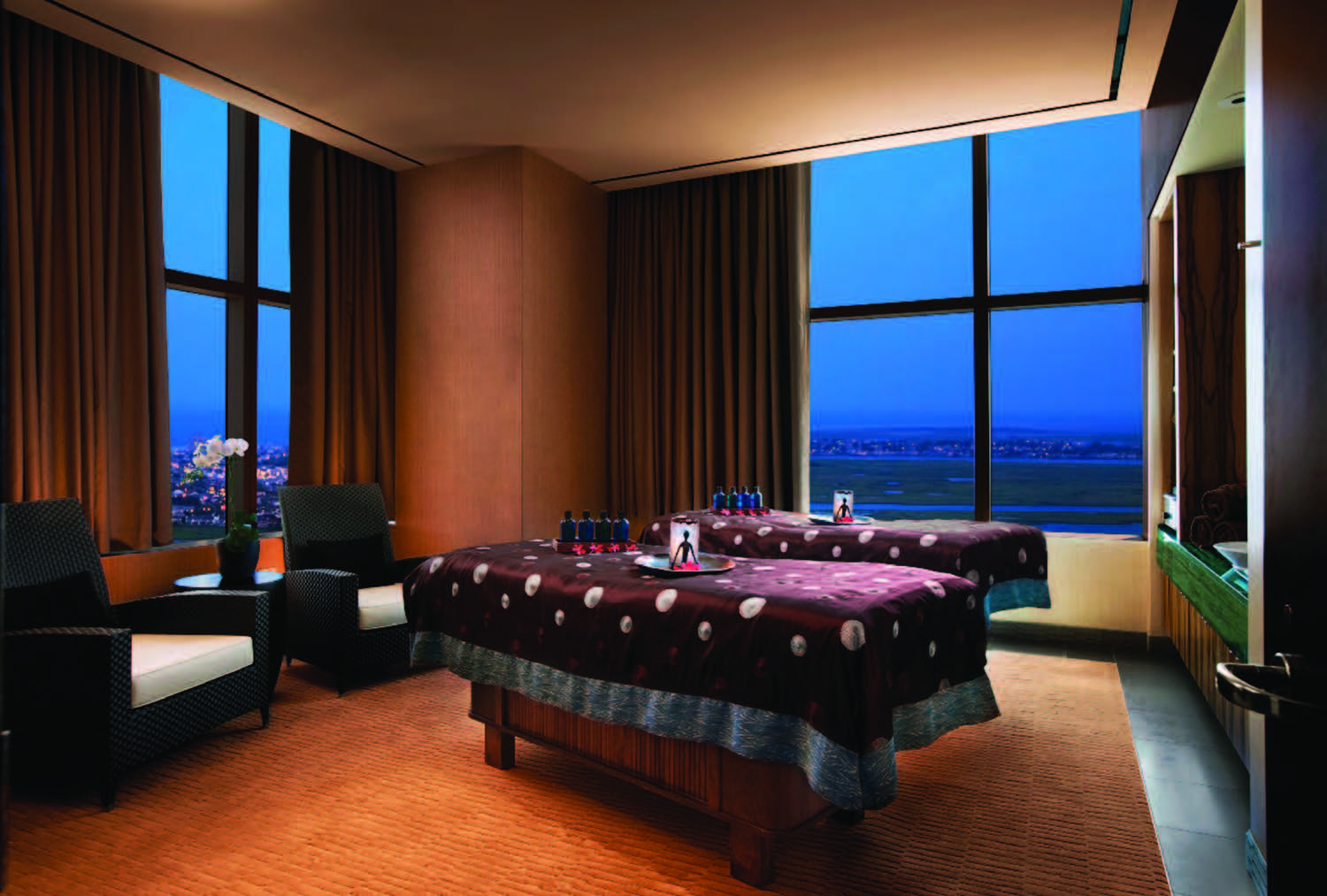
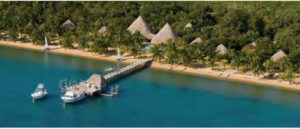
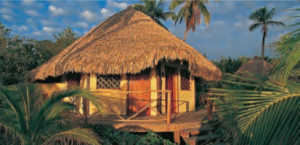

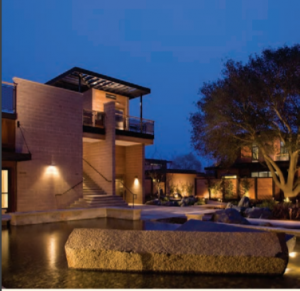
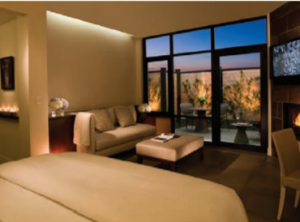
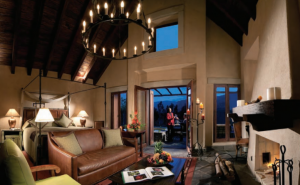
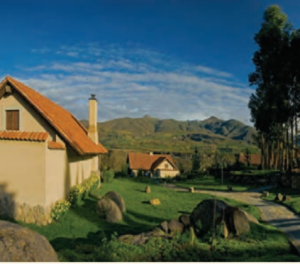
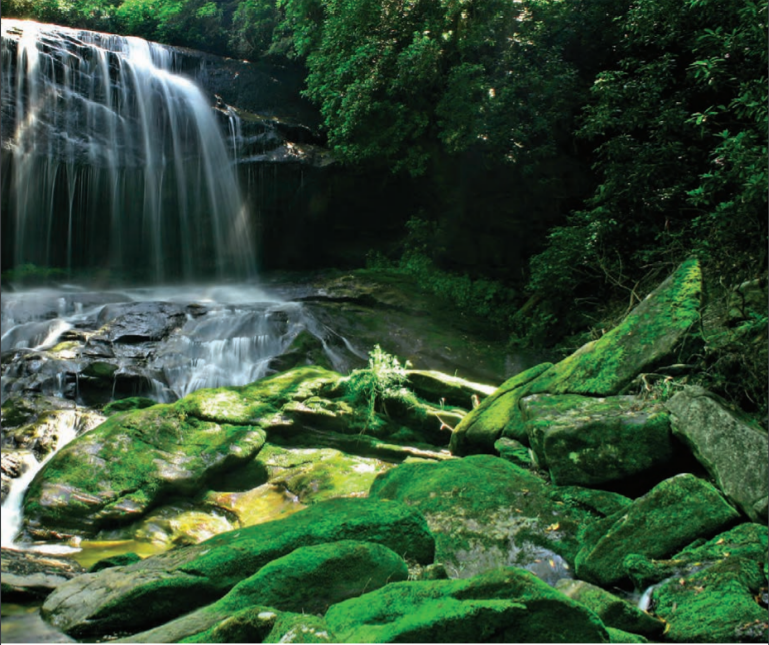
 BLUE LAKE • NEW MEXICO
BLUE LAKE • NEW MEXICO BAHA’I HANGING GARDENS • ISRAEL
BAHA’I HANGING GARDENS • ISRAEL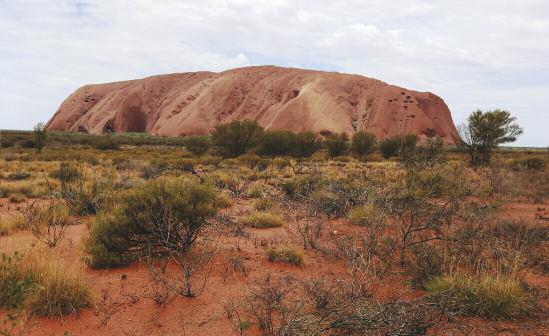 ULURU • AUSTRALIA
ULURU • AUSTRALIA To those who hold Ayers Rock sacred it is known as Uluru. The beliefs that are ascribed to Uluru are integral to what is called The Dreaming—which holds that the spirits of human ancestors came to earth to create the land and all its features. Once their work was completed, those same spirits remained and changed from human form into stars, sunsets, rocks, rivers, shrubs, trees, stones and animals. As such they are ever-present. For Aboriginal believers, The Dreaming is never-ending, linking the past and the present, the people and the land; all that is sacred is in the land.
To those who hold Ayers Rock sacred it is known as Uluru. The beliefs that are ascribed to Uluru are integral to what is called The Dreaming—which holds that the spirits of human ancestors came to earth to create the land and all its features. Once their work was completed, those same spirits remained and changed from human form into stars, sunsets, rocks, rivers, shrubs, trees, stones and animals. As such they are ever-present. For Aboriginal believers, The Dreaming is never-ending, linking the past and the present, the people and the land; all that is sacred is in the land.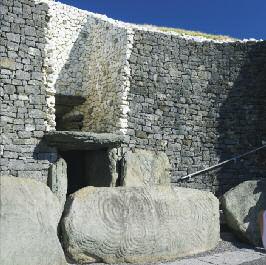 NEWGRANGE • IRELAND
NEWGRANGE • IRELAND
 Lapa Rios • Osa Peninsula • Costa Rica
Lapa Rios • Osa Peninsula • Costa Rica Americas (and #5 in the world) on the Environmental Performance Index and has been cited by the United Nations Development Program for “attaining high human development and equality as well as environmental sustainability.” Located near Corcovado National Park, Lapa Rios is ranked among National Geographic’s Top 50 Ecolodges, Forbes Traveler’s Hotels with the Most Beautiful Views, and is one of the best hotels in the world according to both Travel + Leisure and Condé Nast Traveler. Lapa Rios has also been awarded the Rainforest Alliance’s Sustainable Standard-Setters Award, as well as the 5 Leaf Award Certificate of Sustainable Tourism.
Americas (and #5 in the world) on the Environmental Performance Index and has been cited by the United Nations Development Program for “attaining high human development and equality as well as environmental sustainability.” Located near Corcovado National Park, Lapa Rios is ranked among National Geographic’s Top 50 Ecolodges, Forbes Traveler’s Hotels with the Most Beautiful Views, and is one of the best hotels in the world according to both Travel + Leisure and Condé Nast Traveler. Lapa Rios has also been awarded the Rainforest Alliance’s Sustainable Standard-Setters Award, as well as the 5 Leaf Award Certificate of Sustainable Tourism. SUMMER FUN
SUMMER FUN Campi ya Kanzi • Mtito Andei • Kenya
Campi ya Kanzi • Mtito Andei • Kenya Campi ya Kanzi utilizes ecotourism to support environmental conservation and sustainable community development, partnering with and advocating for the local Maasai community. The lodge uses rain cropping for water, gathers electricity and hot water from solar panels, and cooks all food with eco-friendly charcoal. Guests can choose between a luxury canvas-tented cottage or a private villa in the bush (which is larger and more family-friendly). In addition to the cost of housing each day, visitors pay a $100 conservation fee to the Maasai Wilderness Conservation Trust, which is used to compensate Massai landlords for livestock losses to predators. In essence, every family visiting the property is paying the locals not to shoot lions and other big cats, which is the definition of money well spent.
Campi ya Kanzi utilizes ecotourism to support environmental conservation and sustainable community development, partnering with and advocating for the local Maasai community. The lodge uses rain cropping for water, gathers electricity and hot water from solar panels, and cooks all food with eco-friendly charcoal. Guests can choose between a luxury canvas-tented cottage or a private villa in the bush (which is larger and more family-friendly). In addition to the cost of housing each day, visitors pay a $100 conservation fee to the Maasai Wilderness Conservation Trust, which is used to compensate Massai landlords for livestock losses to predators. In essence, every family visiting the property is paying the locals not to shoot lions and other big cats, which is the definition of money well spent.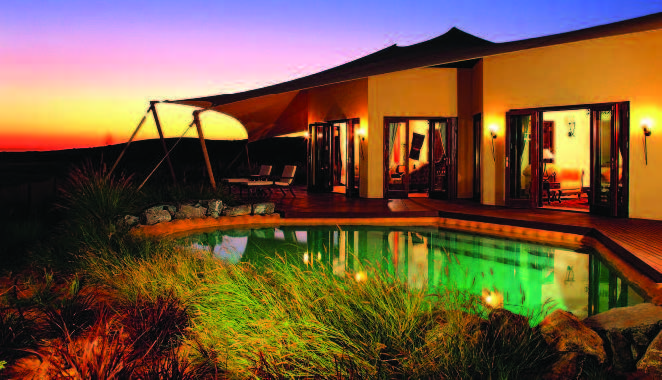 Al-Maha Desert Resort & Spa • Dubai
Al-Maha Desert Resort & Spa • Dubai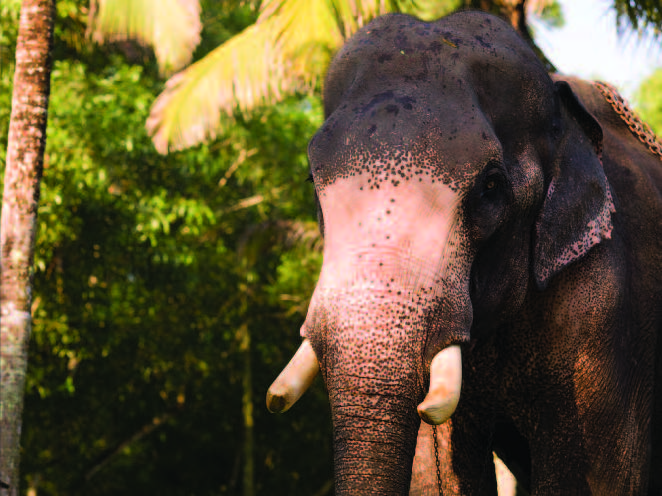 Satwa Elephant Eco Lodge
Satwa Elephant Eco Lodge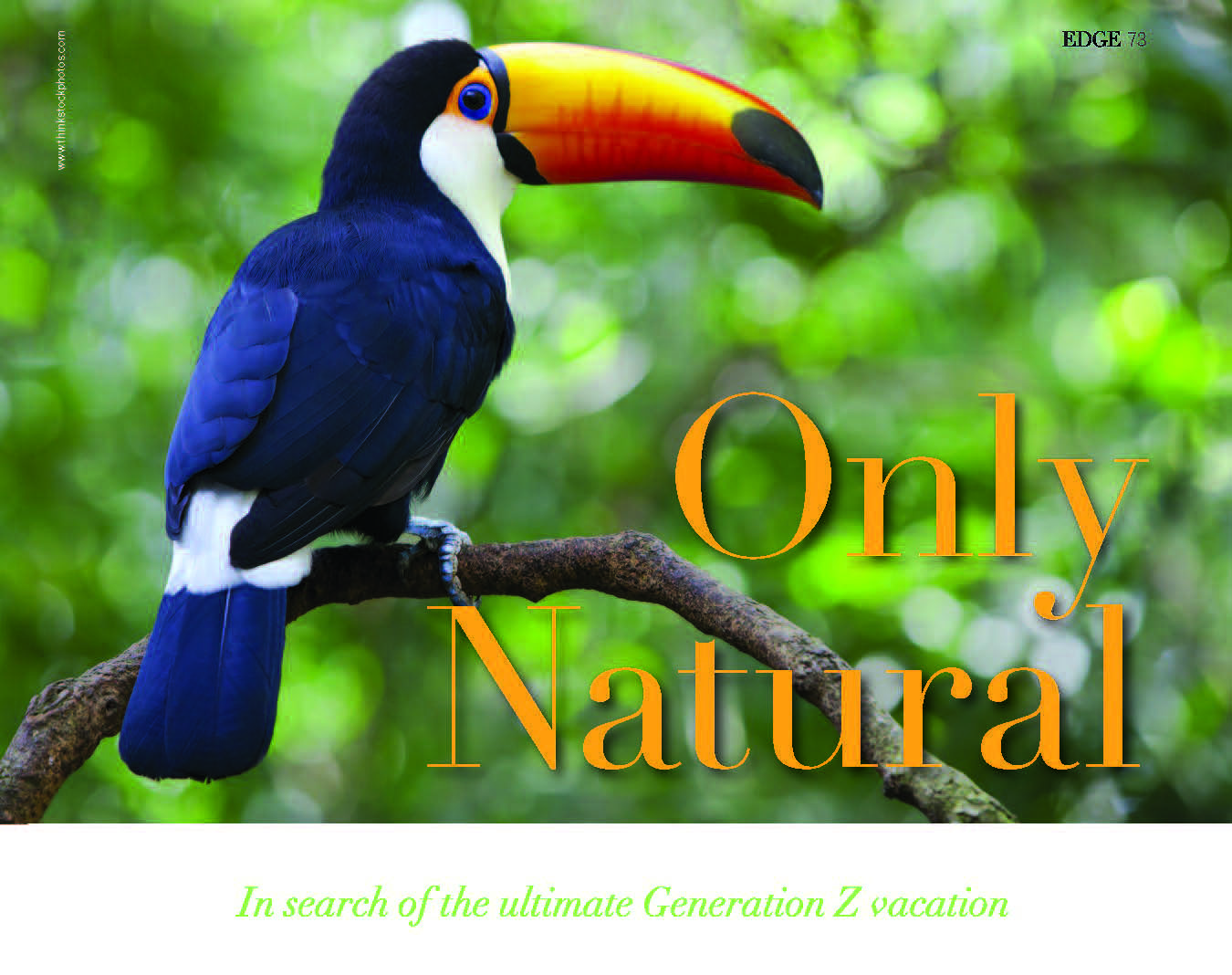

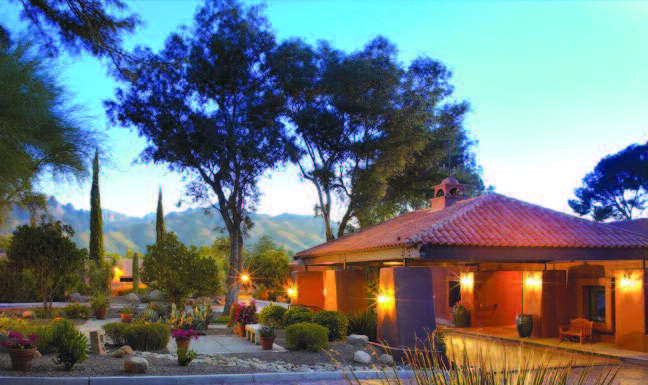 The biggest benefit of a well-cation is the jump-start it offers toward reaching your wellness goal. Staying on-program is much easier when the stresses of everyday life are removed and only healthy activities and meals are offered. And since guests share the same outlook, they support one another to stay committed toward reaching their wellness goals. The investment in a wellness vacation continues to pay off when new habits take hold after the vacation has ended. This may explain why the number of people who are investing their time and money in wellness-related travel has been on the rise. The worldwide wellness tourism market—estimated by some at over $400 billion—has been growing steadily since 2007, increasing nearly 13 percent last year.
The biggest benefit of a well-cation is the jump-start it offers toward reaching your wellness goal. Staying on-program is much easier when the stresses of everyday life are removed and only healthy activities and meals are offered. And since guests share the same outlook, they support one another to stay committed toward reaching their wellness goals. The investment in a wellness vacation continues to pay off when new habits take hold after the vacation has ended. This may explain why the number of people who are investing their time and money in wellness-related travel has been on the rise. The worldwide wellness tourism market—estimated by some at over $400 billion—has been growing steadily since 2007, increasing nearly 13 percent last year. There are a number of weight loss retreats in the region, including the Copperhood Retreat & Spa in the Catskills. It has been touted as one of the best in the world. The three-night detox plan costs about $1,500, while the 21-day “Break Your Bad Habits” plan rate is about $8,000, depending on what level of accommodations is chosen.
There are a number of weight loss retreats in the region, including the Copperhood Retreat & Spa in the Catskills. It has been touted as one of the best in the world. The three-night detox plan costs about $1,500, while the 21-day “Break Your Bad Habits” plan rate is about $8,000, depending on what level of accommodations is chosen. Detoxification
Detoxification Fitness
Fitness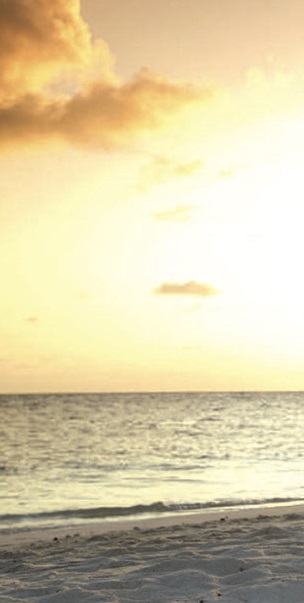
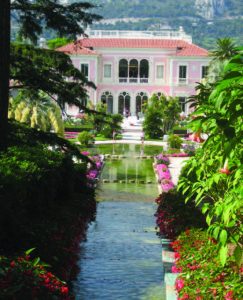 My secret? For three decades, I—and now my family of four—have been enjoying a two-bedroom efficiency villa at the family-run Domaine de la Source, just 10 minutes north of the Menton beaches and a half-hour from Monaco for around $1,000 for a week in high season. Once an olive grove, Domaine de la Source offers twelve rental apartments and two pools. It’s hardly the region’s only bargain-priced accommodation, just the one we swear by. We make our own breakfast in the closet-sized but clean kitchen and venture out each day to explore this remarkable part of the Mediterranean coast.
My secret? For three decades, I—and now my family of four—have been enjoying a two-bedroom efficiency villa at the family-run Domaine de la Source, just 10 minutes north of the Menton beaches and a half-hour from Monaco for around $1,000 for a week in high season. Once an olive grove, Domaine de la Source offers twelve rental apartments and two pools. It’s hardly the region’s only bargain-priced accommodation, just the one we swear by. We make our own breakfast in the closet-sized but clean kitchen and venture out each day to explore this remarkable part of the Mediterranean coast. Just west of Monaco, the gardens and museum at Villa Ephrussi Rothschild in Cap Ferrat are like a journey back to the Belle Epoque era. The villa was built in 1905 by the eccentric Mme. Beatrice Ephrussi de Rothschild of the famed banking family, who divorced M. Ephrussi—scion of Russian wheat merchants of The Hare with the Amber Eyes—before his gambling debts and ill-advised speculations could ruin her. The villa showcases her eclectic tastes, ranging from Meissen china and Aubusson carpets to genre art of Boucher and Fragonard to a collection of embroidered silk shoes for Chinese bound feet. Though childless, she treated her dogs, monkeys and mongoose as family, once throwing a lavish mock wedding for Diane and Major, her two poodles. The event featured printed invitations and hundreds of human and canine guests (all in formal attire), including a bulldog sporting a top hat. During the ceremony, the “bride” had a gold ring set in diamonds slipped onto her paw. Mme. Ephrussi de Rothschild was just as passionate about gardening. The grounds offer nine different restored gardens that overlook the Mediterranean and choreographed fountain displays. An audio guide is well worth the $20 fee.
Just west of Monaco, the gardens and museum at Villa Ephrussi Rothschild in Cap Ferrat are like a journey back to the Belle Epoque era. The villa was built in 1905 by the eccentric Mme. Beatrice Ephrussi de Rothschild of the famed banking family, who divorced M. Ephrussi—scion of Russian wheat merchants of The Hare with the Amber Eyes—before his gambling debts and ill-advised speculations could ruin her. The villa showcases her eclectic tastes, ranging from Meissen china and Aubusson carpets to genre art of Boucher and Fragonard to a collection of embroidered silk shoes for Chinese bound feet. Though childless, she treated her dogs, monkeys and mongoose as family, once throwing a lavish mock wedding for Diane and Major, her two poodles. The event featured printed invitations and hundreds of human and canine guests (all in formal attire), including a bulldog sporting a top hat. During the ceremony, the “bride” had a gold ring set in diamonds slipped onto her paw. Mme. Ephrussi de Rothschild was just as passionate about gardening. The grounds offer nine different restored gardens that overlook the Mediterranean and choreographed fountain displays. An audio guide is well worth the $20 fee.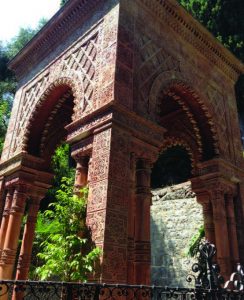 We especially enjoy touring the medieval hill towns, sited centuries ago high above the sea to protect the populace from pillaging Saracens. Eze, built above Cap Ferrat, is the most heavily trafficked by tourists. Its narrow lanes, which lead to a chateau, evoke life in the Middle Ages and the town has a stunning panoramic view of the Cote d’Azur. There is a two-Michelin-starred restaurant, Le Chevre d’Or, which is well worth the splurge for a meal (or maybe just a kir royale) near the top of Eze. The less-touristy hill towns of Roquebrune and Gorbio require stellar driving skills and steel nerves to negotiate the narrow roads and hairpin turns. The charming hill towns of Italy, near the French frontier, are also lovely and relatively tourist-free.
We especially enjoy touring the medieval hill towns, sited centuries ago high above the sea to protect the populace from pillaging Saracens. Eze, built above Cap Ferrat, is the most heavily trafficked by tourists. Its narrow lanes, which lead to a chateau, evoke life in the Middle Ages and the town has a stunning panoramic view of the Cote d’Azur. There is a two-Michelin-starred restaurant, Le Chevre d’Or, which is well worth the splurge for a meal (or maybe just a kir royale) near the top of Eze. The less-touristy hill towns of Roquebrune and Gorbio require stellar driving skills and steel nerves to negotiate the narrow roads and hairpin turns. The charming hill towns of Italy, near the French frontier, are also lovely and relatively tourist-free.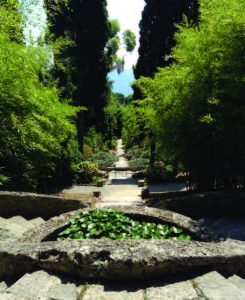 Across the border from Menton, in Italy, is Hanbury Gardens (left), near Ventimiglia. Built in the 19th century by Lord Hanbury, a British diplomat—who like many travelers of that age gathered exotic flora from far flung lands of the former British Empire—created a landscape with Moorish and Oriental follies. The garden is quite vertical and dramatic, stretching down to the Mediterranean.
Across the border from Menton, in Italy, is Hanbury Gardens (left), near Ventimiglia. Built in the 19th century by Lord Hanbury, a British diplomat—who like many travelers of that age gathered exotic flora from far flung lands of the former British Empire—created a landscape with Moorish and Oriental follies. The garden is quite vertical and dramatic, stretching down to the Mediterranean.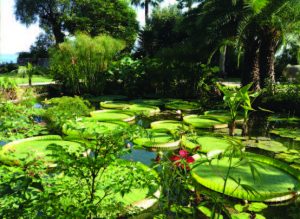 The food in the port towns along the Cote d’Azur does not require a second mortgage. There are any number of small restaurants offering thin-crust pizza, fresh salads, mussels, and pain bagnat (a Niçoise version of a tuna sandwich) for a reasonable price. Menton (right) is a lovely old port town with affordable shops and pizzerias and a large Beaux Art farmers’ market selling artisanal baguettes, cured meats and cheeses that are perfect for a beach picnic.
The food in the port towns along the Cote d’Azur does not require a second mortgage. There are any number of small restaurants offering thin-crust pizza, fresh salads, mussels, and pain bagnat (a Niçoise version of a tuna sandwich) for a reasonable price. Menton (right) is a lovely old port town with affordable shops and pizzerias and a large Beaux Art farmers’ market selling artisanal baguettes, cured meats and cheeses that are perfect for a beach picnic.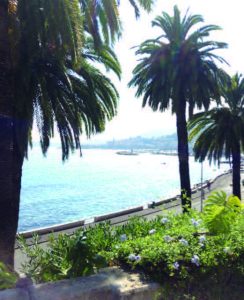 With the Euros we save on pauper-priced lodging, attractions and meals, we like to treat ourselves to at least one gourmet French meal fit for a prince or princess. There is a Michelin two-star restaurant right on the water and right on the Italy/France border called Mirazur. It’s worth every penny of the $100 per person (not including wine) price tag, and you will definitely need reservations. And of course, there are the grand hotel restaurants of Monaco—many on rooftops overlooking the water—which prepare true gastronomic adventures. They are delicious…mais tres cher!
With the Euros we save on pauper-priced lodging, attractions and meals, we like to treat ourselves to at least one gourmet French meal fit for a prince or princess. There is a Michelin two-star restaurant right on the water and right on the Italy/France border called Mirazur. It’s worth every penny of the $100 per person (not including wine) price tag, and you will definitely need reservations. And of course, there are the grand hotel restaurants of Monaco—many on rooftops overlooking the water—which prepare true gastronomic adventures. They are delicious…mais tres cher!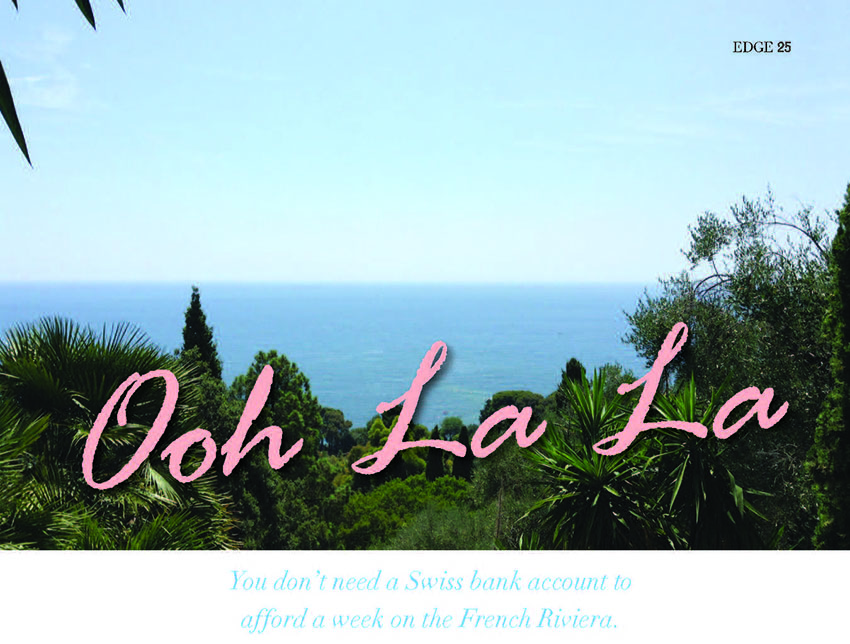

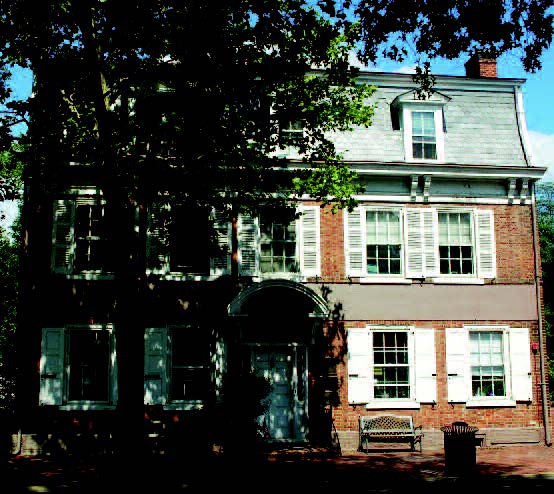
 PAINT THE TOWN RED
PAINT THE TOWN RED



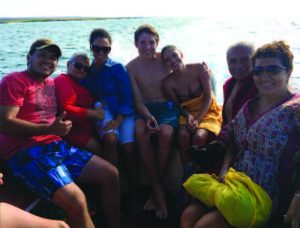 The members of my international crew were actually part of a sort of extended family. My Ukrainian-American mother, Christina, had retired to a seaside village in Ecuador a few years ago. Her Ecuadorian friend, Maria, came up with the idea to make the trip to the islands (which sit roughly 600 miles off the Ecuadorian coast). It turns out Maria’s parents had actually lived on one of the islands, Floriana, some 70 years ago, when her father worked for the government. Yet neither Maria nor my mother had ever been.
The members of my international crew were actually part of a sort of extended family. My Ukrainian-American mother, Christina, had retired to a seaside village in Ecuador a few years ago. Her Ecuadorian friend, Maria, came up with the idea to make the trip to the islands (which sit roughly 600 miles off the Ecuadorian coast). It turns out Maria’s parents had actually lived on one of the islands, Floriana, some 70 years ago, when her father worked for the government. Yet neither Maria nor my mother had ever been. We began our journey in Puerto Ayora, most populous town on Santa Cruz and the tourist hub of the islands. There we began our love affair with Galapagos snorkeling. The biodiversity was astounding, though not always what I’d expected. I’ve done a lot of snorkeling in warm water, including the Red Sea, where colorful fish and plants live among stunning coral formations. In the frigid waters off Santa Cruz, the colors were muted and the sea floor crowded with starfish, sea cucumbers and various non-tropical fish species. In the deep water areas sharks swam stealthily below us.
We began our journey in Puerto Ayora, most populous town on Santa Cruz and the tourist hub of the islands. There we began our love affair with Galapagos snorkeling. The biodiversity was astounding, though not always what I’d expected. I’ve done a lot of snorkeling in warm water, including the Red Sea, where colorful fish and plants live among stunning coral formations. In the frigid waters off Santa Cruz, the colors were muted and the sea floor crowded with starfish, sea cucumbers and various non-tropical fish species. In the deep water areas sharks swam stealthily below us. THE LOCALS
THE LOCALS
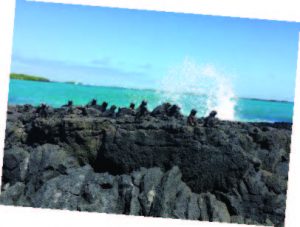 GALAPAGOS IN A BOX
GALAPAGOS IN A BOX
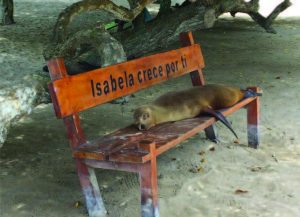 My mother, who is nearly 70, is in pretty good health and full of energy. She observed that many of the activities may be too challenging for families with small children or people with a physical infirmity, even a slight one, due to some of the terrain like steep steps, long walks and the need to constantly climb in and out of small boats.
My mother, who is nearly 70, is in pretty good health and full of energy. She observed that many of the activities may be too challenging for families with small children or people with a physical infirmity, even a slight one, due to some of the terrain like steep steps, long walks and the need to constantly climb in and out of small boats.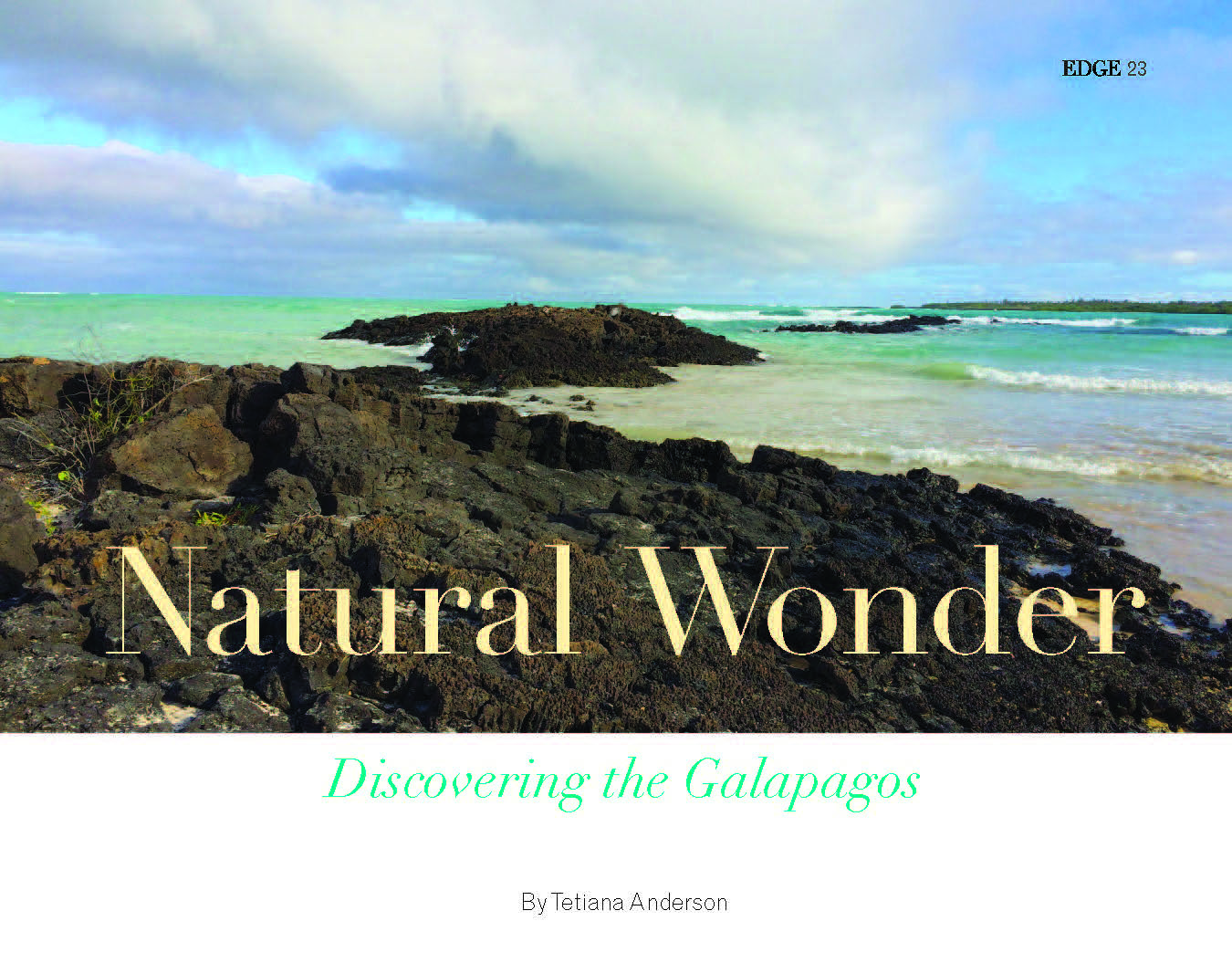
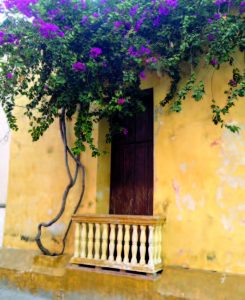
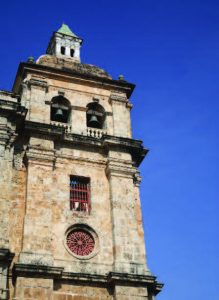
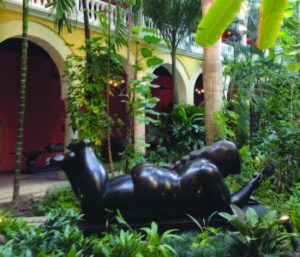
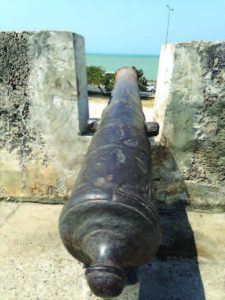
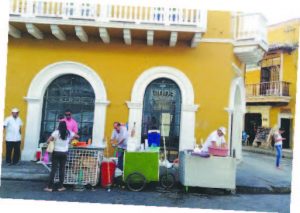 SAFETY FIRST
SAFETY FIRST SO WHAT EXACTLY HAPPENED?
SO WHAT EXACTLY HAPPENED?